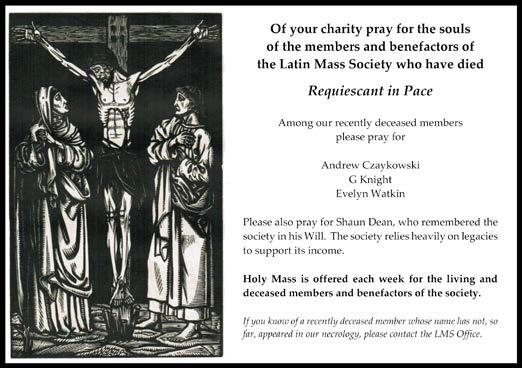

Mass of Ages
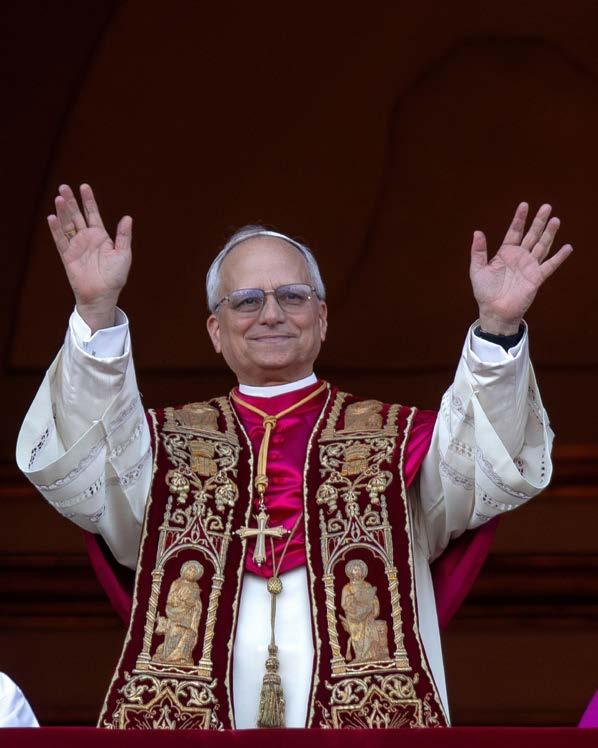
The wisdom of the theologian: will Leo XIV embrace Benedict’s spirit of the liturgy?
Fr Aidan Nichols on the gifts of the Holy Spirit
Ad multos annos to the Latin Mass Society!
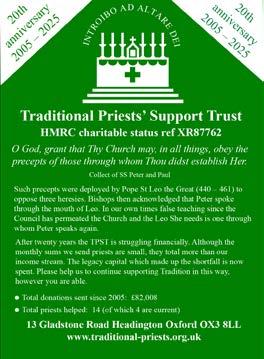

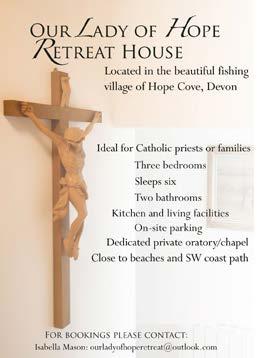
ourladyofhoperetreat.co.uk
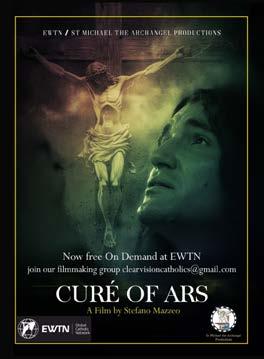
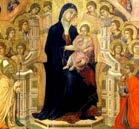

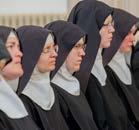
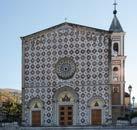
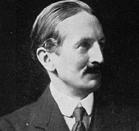
Year planner
LMS conference
Awe and admiration
Daniel Jahansouz reports from a remarkable National Gallery exhibition 12 Sacred light
Gwyneth Thompson-Briggs was commissioned to paint the special patrons of the LMS.
Here she explains her love for the martyrs of England and Wales 14 World News: Chartres Pilgrimage
Paul Waddington reports from France 16 Spirituality
Fr Crean remembers Edmund of East Anglia
18 A dazzling list
Mary O’Regan on the Saints of 23 September 20 The wisdom of the theologian
Will Leo XIV embrace Benedict’s spirit of the liturgy, asks Dr Fredrick Wolf 22 Finally redeemed
Sebastian Morello on the delights of Gordon’s Morello Cherry Gin
24 ‘Ad multos annos’ to the Latin Mass Society! 27 Family matters
James Preece on mortality 28 Art and devotion
Caroline Farey discusses a painting that shows Catholic culture at its fullest 30 Theology
Fr Aidan Nichols on the gifts of the Holy Spirit
32 His gentle gaze…
Edward Dundon on the remarkable history of the Veil of Manoppello
34 Reports from around the country
What’s happening where you are
40 Keeping watch
Adult convert Joseph Jarvis explains how experience at sea provided valuable lessons in becoming a Catholic
43 The Catholic Gael
Charles A. Coulombe remembers Ruaraidh Erskine of Mar

The Latin Mass Society
Mallow
Mass of Ages
Editor: Tom Quinn, editor@lms.org.uk
Design: GADS Ltd & Selina Fang
Printers: Intercity Communications Ltd
Due to the considerable volume of emails and letters received at Mass of Ages, it is regrettably not always possible to reply to all correspondents.
DISCLAIMER: Please note that the views expressed in this publication are not necessarily those of the Latin Mass Society or the Editorial Board. Great care is taken to credit photographs and seek permission before publishing, though this is not always possible. If you have a query regarding copyright, please contact the Editor. No part of this magazine may be reproduced without written permission.
Cover: Pope Leo. Photo: Alamy
THE LATIN MASS SOCIETY
FOUNDED 1965
PATRONS
Sir Adrian Fitzgerald, Bt The Rt Hon Lord Gill The Rt Hon Sir Edward Leigh, MP
Sir James Macmillan, CBE . The Lord Moore of Etchingham Prof. Thomas Pink . John Smeaton
COMMITTEE
CHAIRMAN: Dr Joseph Shaw
SECRETARY: David Forster
TREASURER: Sarah Ward
HONORARY OFFICERS:
Alastair Tocher
Paul Waddington
OTHER COMMITTEE MEMBERS:
Selina Fang, Julia Jones, Kevin Jones, Antonia Robinson, Aileen Seymour
NATIONAL CHAPLAIN:
Mgr Gordon Reid
STAFF AND FREELANCERS
GENERAL MANAGER: Richard Pickett, richard@lms.org.uk
FINANCIAL ADMINISTRATOR: Gareth Copping, gareth@lms.org.uk
OFFICE ASSISTANT: Mauricio Rodriguezs, info@lms.org.uk
ADMINISTRATION OFFICER: Hamish Rogers, hamish@lms.org.uk
EDITOR, MASS OF AGES: Tom Quinn, editor@lms.org.uk
COMMUNICATIONS OFFICER: Daniel Beurthe, daniel@lms.org.uk
CREATIVE CONTENT PRODUCER: Clive Watson, clive@lms.org.uk
LONDON DIRECTOR OF MUSIC: Dominic Bevan, southwell@lms.org.uk
VOLUNTARY ROLES
SAFEGUARDING: David Forster, safeguarding@lms.org.uk
GUILD OF ST CLARE: Lucy Shaw, guildofstclare@lms.org.uk
GREGORIAN CHANT NETWORK: Alastair Tocher, chant@lms.org.uk
SOCIETY OF ST TARCISIUS: Dr Joseph Shaw, tarcisius@lms.org.uk
EDITOR, LMS ORDO: Peter Day-Milne, ordo@lms.org.uk
LOCAL REPRESENTATIVES
ARUNDEL & BRIGHTON: Dr Emma-Louise Jay, arundel@lms.org.uk
BIRMINGHAM (City & Black Country) : Louis Maciel, birmingham@lms.org.uk
BIRMINGHAM (North Staffordshire) : Alan Frost, staffs@lms.org.uk
BIRMINGHAM (Oxford) : Dr Joseph Shaw, oxford@lms.org.uk
BIRMINGHAM (Warwickshire) : John Bradley, warwickshire@lms.org.uk
BIRMINGHAM (Worcestershire) : Alastair Tocher, malvern@lms.org.uk
BRENTWOOD (East) : Alan Gardner, brentwoodeast@lms.org.uk
BRENTWOOD (London) : Mark Johnson, brentwood@lms.org.uk
CARDIFF-MENEVIA (Cardiff) : Andrew Butcher, cardiff@lms.org.uk
CARDIFF-MENEVIA (Herefordshire) : Shaun Bennett, herefordshire@lms.org.uk
CARDIFF-MENEVIA ( Ledbury) : Alastair Tocher, malvern@lms.org.uk
CARDIFF-MENEVIA ( Menevia) : Tom & Elaine Sharpling, menevia@lms.org.uk
CLIFTON: James and Mari Carmen Osborn, clifton@lms.org.uk
EAST ANGLIA ( Walsingham) : Tom Fitzpatrick, walsingham@lms.org.uk
EAST ANGLIA (West) : Gregor & Alisa Dick, cambridge@lms.org.uk
EAST ANGLIA ( Withermarsh Green) : Sarah Ward, withermarshgreen@lms.org.uk
HEXHAM & NEWCASTLE: John Fagan, hexham@lms.org.uk
LANCASTER: John Rogan, lancaster@lms.org.uk
LANCASTER (Cumbria) : Nicholas Steven, warwickbridge@lms.org.uk
LIVERPOOL: Andrew Doyle, liverpool@lms.org.uk
LIVERPOOL (Warrington) : Alan Frost, warrington@lms.org.uk
MIDDLESBROUGH: Paul Waddington, middlesbrough@lms.org.uk
NORTHAMPTON (South) : Barbara Kay, bedford@lms.org.uk
NOTTINGHAM: Jeremy Boot, nottingham@lms.org.uk
NOTTINGHAM (South) : Paul Beardsmore, northampton@lms.org.uk
PLYMOUTH (Cornwall) : Stefano Mazzeo, cornwall@lms.org.uk
PLYMOUTH (Devon) : Patrick Oliver, devon@lms.org.uk
PLYMOUTH (Dorset) : Maurice Quinn, dorset@lms.org.uk
PORTSMOUTH: Carol Turner, portsmouth@lms.org,uk
PORTSMOUTH (Isle of Wight) : Peter Clarke, iow@lms.org.uk
SALFORD: Alison Fraser-Kudlowski, salford@lms.org.uk
SHREWSBURY (Cathedral) : Victoria Keens, shrewsbury@lms.org.uk
SHREWSBURY (Wirral) : Kevin Jones, wirral@lms.org.uk
SOUTHWARK (Cathedral) : Oliver McCarthy, southwark@lms.org.uk
SOUTHWARK (Chislehurst) : Christopher Richardson, chislehurst@lms.org.uk
SOUTHWARK (Clapham Park) : Thomas Windsor, claphampark@lms.org.uk
SOUTHWARK (Kent) : Marygold Turner, kent@lms.org.uk
SOUTHWARK (Thanet) : Dr Christopher Serpell, thanet@lms.org.uk
SOUTHWARK (Wandsworth) : Julia Ashenden, wandsworth@lms.org.uk
WESTMINSTER (Cathedral) : Edward Kendall, westminster@lms.org.uk
WESTMINSTER (Hertfordshire): Tom Short, herts@lms.org.uk
WESTMINSTER (Warwick Street): Nicolas Ollivant, warwickstreet@lms.org.uk
WESTMINSTER (Willesden) : Mauricio Rodriguez, willesden@lms.org.uk
Criss-crossing the country
Joseph Shaw on the Latin Mass Society’s continuing anniversary year
Iwrite half-way through our Anniversary Year, and just before our busiest time, which is the final preparations for our August events, followed by the events themselves, of the St Catherine’s Trust Summer School, the Residential Latin Course, and the Walsingham Pilgrimage.
We have now had Bishop Schneider’s tour, and our Annual General Meeting, and as well as a sold-out conference in London; we have seen high-profile Masses in Northampton, Ramsgate, Reading, and Preston. In the autumn, we look forward to having another episcopal tour, of the retired Swiss auxiliary bishop Marian Eleganti, who will visit Bedford, New Brighton, and Oxford. With our annual events from Chideock in Dorset to Walsingham, we may not have visited every last corner of the kingdom, but we have done quite well. In the meantime, our True Cross Relic Tour is criss-crossing the country in even more detail.
‘I urge readers who are not members to join us: it’s not too much to ask to put a little of your money behind your convictionsʼ
After 60 years of work, the Latin Mass Society is still an organisation that spans the country: in some ways, more than ever. Our work extends to areas of the life of the Church that would have impressed our founders: we support a Summer School for children; our Guild of St Clare runs a Sewing Retreat (this year both are already fully booked); we have a Residential Latin Course (heading in the same direction at the time of writing). At the same time, readers will see in these pages announcements of four Gregorian Chant training events, in collaboration with the Schola Gregoriana of Cambridge, marking a renewed effort to promote this form of music which, as the Second Vatican Council reminded us, is ‘proper’ to the Roman liturgy (‘Ecclesiae cantum gregorianum agnoscat ut liturgiae romanaeproprium’). Who else is taking Vatican II seriously on this point?
These are not huge events in themselves, but then they all involve things that can only be done in small groups. The trick is to keep doing them, and by keeping them up, gradually to increase our capacity to do them, for example by nurturing more people capable of passing on important skills to others.
If you are reading this, it seems likely that you approve of all this activity. If you are actively supporting our work, with your time, that most valuable of all resources, or as a member, I thank you. I urge readers who are not members to join us: it’s not too much to ask to put a little of your money behind your convictions.
More than this, we are this year reviving a scheme we established for our 50th anniversary, when we invited people to give an extra, monthly, donation, to become ‘Anniversary Supporters’: some of these are still

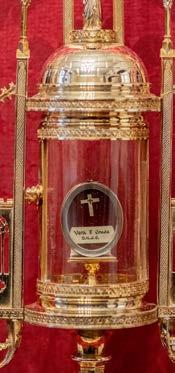
contributing their extra donations ten years later. This year, please consider joining our Ad Futurum scheme, and commit to a regular monthly gift. Without you, our loyal supporters, the Latin Mass Society would not have survived until now; without you, we would not be able to do the work that we are doing today. With you, we can look forward with confidence to another 60 years: and a good deal beyond that as well.
The True Cross relic
Year Planner
At the time of going to press the following events are planned. For fuller details and other events see lms.org.uk.

HOLY CROSS PILGRIMAGE
To mark the Jubilee Year 2025 and the LMS’ Sixtieth Anniversary a relic of the True Cross is visiting churches throughout England and Wales. To find out when the relic is in your area visit the official website: holycross2025.org. Prayer petitions can be left on the website. The relic will be present at events marked with an asterisk (*) below.
LMS Residential Latin Course, 11-16 August, Boars Hill Carmelite Priory, Oxford. Expert tuition in ecclesiastical Latin. Information and booking: lmw.org.uk/events.
Annual Sung Mass for the Sodality St Augustine, on Monday 18 August, Corpus Christi, Maiden Lane, London, 6.30 pm. lms.org.uk/sodality
LMS Walsingham Walking Pilgrimage, 21-24 August. Annual walking pilgrimage from Ely to Walsingham. Booking deadline: 15 August. Day Pilgrimage on Sunday 24 August with 2 pm High Mass at Shrine and Procession into Walsingham. Information and booking: lmw.org.uk/walsingham.*
York Martyrs Pilgrimage, Monday 25 August. Annual pilgrimage in honour of St Margaret Clitherow and the Martyrs of York. 10 am veneration of St Margaret’s relic, Bar Convent, Blossom Street, York YO24 1AQ. 10.45 am Procession through York. Noon Solemn Mass, St Wilfrid's Church. 2 pm Benediction.
Mass for Chinese Catholics, Monday 8 September. The Feast of the Nativity of Our Lady occurs on the anniversary of the beginning of persecution in 1958, a pivotal moment for the Chinese faithful. Corpus Christi Maiden Lane, London, 6.30pm.
Chiddiock Martyrs’ Pilgrimage, Saturday 20 September. High Mass followed by devotions, 12 noon.*
Snave Sung Mass, Saturday 20 September. Annual Sung Mass at the medieval church of St Augustine, Snave, on the Romney Marsh, 12 noon.
Society of St Tarcisius Server Training Day & Guild of St Clare Vestment Mending Day, Saturday 20 September. St Mary Moorfields, London, 10.30 am to 4 pm. Booking for server training: lms.org.uk/events.
Oxford Martyrs’ Pilgrimage, Saturday 11 October. High Mass at Blackfriars, St Giles, Oxford, 11.00 am followed by Procession and Benediction.
St Birinus Festival, 16 – 19 October. The Southwell Consort will be joined by sackbutts and cornets to present Solemn Mass and the major hours according to the 1962 Roman Missal, with full renaissance polyphony and Gregorian chant. Dorchester Abbey, Oxfordshire. southwellconsort.com
Gregorian Chant Training Day, Saturday 25 October, St William of York, Reading. With Iain Simcock of the Schola Gregoriana. From 10.45 am, with Mass of Our Lady at 5:30pm. Booking at lms.org.uk/events.
Rome Pilgrimage – Peregrinatio ad Petri Sedem, including 10th Pax Liturgica Gathering, 24-26 October. en.summorumpontificum.org.
VISIT OF BISHOP MARIAN ELEGANTI
Pontifical High Mass of All Saints, Saturday 1 November. Annual Mass of reparation for abortion, Holy Child, Bedford, noon. Followed by reception.*
Pontifical High Mass, Sunday 2 November, SS Peter and Paul, New Brighton, 10.30 am.*
Pontifical Low Mass, Wednesday 5 November, SS Gregory and Augustine, Oxford, 6.00 pm.*
Pontifical High Mass of Requiem, LMS Annual Requiem, Saturday 8 November, Blackriars Priory, Oxford, 11.00 am.*
Catholic Police Guild Annual Sung Requiem, Monday 3 November. Corpus Christi, Maiden Lane, London, 6.30 pm.
Catholic Military Association Annual Sung Requiem, Monday 10 November. Corpus Christi, Maiden Lane, London, 6.30 pm.
Society of St Tarcisius Server Training Day & Guild of St Clare Vestment Mending Day, Saturday 22 November. St Dominic's Haverstock Hill (Rosary Shrine), London, 10.30 am to 4 pm. Booking for server training: lms.org. uk/events.
Gregorian Chant Training Day, St Mary Moorfields, London. All welcome – further details at lms.org.uk
Iota Unum talks in London to be confirmed at the time of going to press. Please see lms.org.uk.
Palestrina 500 Festival, in celebration of the Jubilee Year the Southwell Consort is holding a season of music by Palestrina and his contemporaries at Corpus Christi, Maiden Lane, London, and elsewhere. lms.org.uk/music.
Wanted
David & Theresa O'Neill have for many years raised funds for the Little Sisters of the Poor in Newcastle. This is done by collecting used postage stamps from any country, unwanted or old foreign currency & broken or unwanted pieces of gold & silver. To date £28,400 has been raised & donors are remembered in prayers & Masses of Sisters & residents. Please send to 34 Morston Drive, Newcastle upon Tyne NE15 7RZ.
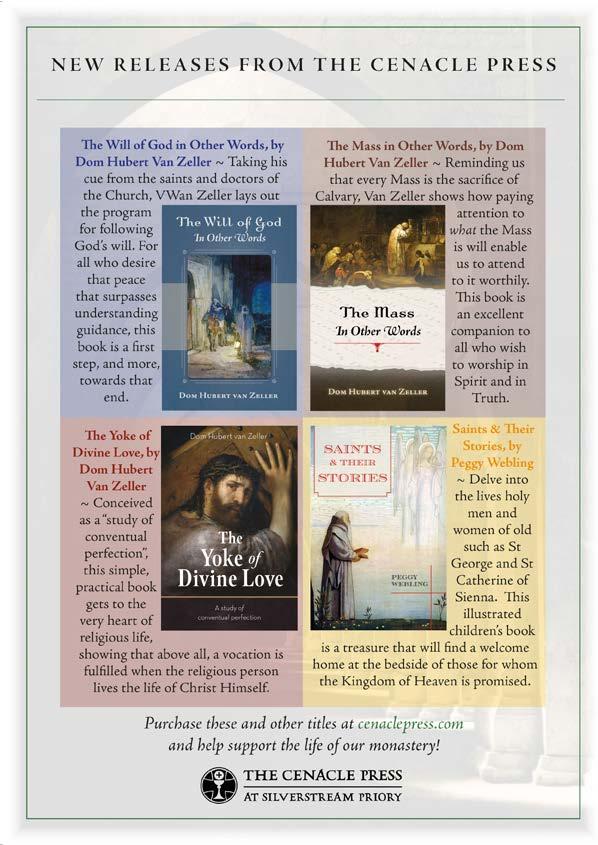
The importance of tradition
A report from the LMS Faith and Culture conference
The atmosphere was buoyant as the Latin Mass Society’s sixtieth anniversary Faith and Culture Conference heard from a range of prominent speakers about the importance of tradition in shaping the church’s mission for the future. All talks are now available to watch on the LMS YouTube channel.
The “sold out” conference at the London Oratory was joined by a global livestream audience, first hearing from Bishop Athanasius Schneider, who was visiting England to participate in the conference and a programme of other LMS anniversary celebrations. Next came the philosopher and LMS Patron, Prof Thomas Pink, who gave an engaging paper on ‘Tradition, secular and religious’ and the historian and journalist Dr Tim Stanley, who captivated the audience with his incisive ‘Reflections on 20 years as a Catholic’.
After lunch, LMS Chairman, Dr Joseph Shaw, rallied the troops, with his address, ‘Evangelising after the cultural revolution’, in which he highlighted the Church’s opportunity to respond to contemporary cultural challenges. The acclaimed contemporary painter, James Gillick, then offered an impactful exposition on how sacred art can engage and transform believers.
The conference concluded with a keynote address by Cardinal Raymond Burke, appearing via video link from America. The Cardinal used the occasion to give a theological commentary on the relationship between the Sacred Liturgy and the Divine Law, the Jus Divinum.
The day concluded with a magnificent celebration of Solemn Pontifical Vespers – the First Vespers of Trinity Sunday –at which Bishop Schneider presided. The visceral beauty of the liturgy—in its sacred music, ceremonial richness, and reverent atmosphere—offered a fitting culmination to the conference. It served as a living expression of the themes explored throughout the day: the power of tradition, the role of beauty in worship, and the enduring vitality of the Church’s liturgical heritage.
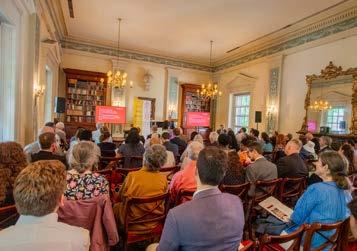
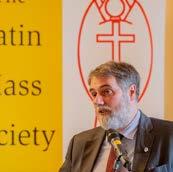
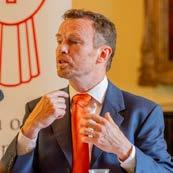


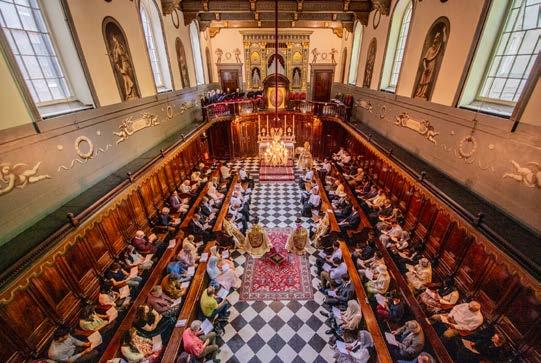
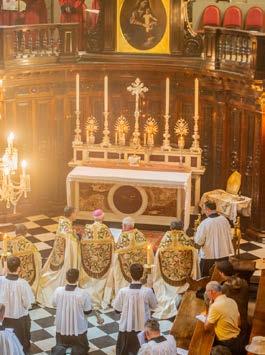
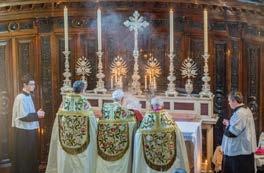
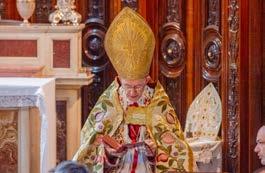
Awe and admiration
Daniel Jahansouz
reports from a remarkable National Gallery exhibition
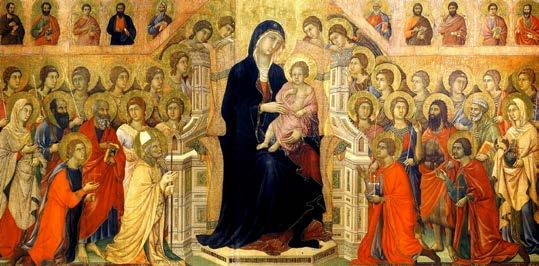
The National Gallery’s exhibition
Siena: The Rise of Painting 13001350 ran this year from 8 March until 25 June. The exhibition gathered together, for the first time in centuries, scenes from Duccio's monumental Maestà altarpiece. This altarpiece is a foundational and integral part of the history of devotional art and using art as a theological medium; it was, after all, the first altarpiece with panels on both the front and the back.
The front panels consist of large portrayal of The Virgin and Child enthroned, flanked with a plenitude of glorious Angels and Saints. The back panels show forty-three remarkable scenes of the life of The Blessed Virgin and of Christ. This is the centre piece of the Siena exhibition, and it does not disappoint. Duccio's magnificent craftsmanship and care speak volumes.
The intricate engravings inlayed within the architecture of the throne, the abundance of byzantine gold which
was inspired and taken from the transrelational materials that the town of Siena had access to via the crusades, are all exceptional.
But the highlight of Siena is in the first room of the exhibition, almost paving the way for Duccio’s Maestà: the triptych of The Virgin and Child with Saints Dominic and Aurea.
The town of Siena is famous for its Marian devotion. This is made clear not only in the written history of the town, but also in the artwork. The 14th century is filled with Marian paintings, but Duccio's unique work feels different. At first glance, one can see The Virgin and Child surrounded by angels, flanked with the founder of the Order of Preachers and the famous abbess. On closer inspection however, one can make out more details, such as the Prophets and Patriarchs above the Virgin and Child holding their elegant scrolls, containing prophecies about the Messiah centuries before He had
come. Now, they are in utter awe and admiration. The angels too, with their dazzling garments, almost peering into the scene. They have their hands clasped together in pure joy. They point and marvel as if to say, ‘Behold! The Lamb of God who takes away the sins of the World! Blessed is He who comes in the name of the Lord, and His Immaculate Mother whom He deemed worthy to bear Him!’
The subject of The Virgin and Child is the literal and metaphorical centrepiece of Siena. Mary's classic blue garments, resembling the maris, or sea, from where she gets Her name. St Thomas Aquinas writes, ‘for just as sailors are directed to port by the star of the sea, so also Christians are guided to glory by Mary: to which may he lead us.’ Her gorgeous blue garb is outlined with gold, even having a star on Her forehead (prefiguring the crown as prophesised in Revelation 12:1), in addition to one on Her
Duccio’s Virgin and Child with Saints Dominic and Aurea
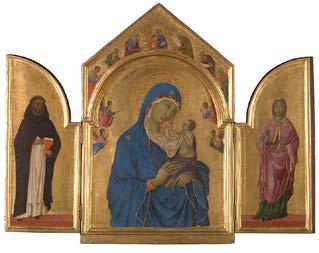
shoulder. Duccio even decided to give Mary these wonderful rosy cheeks. She is utterly, wholly, and totally consumed of Her Son and Lord, the God-Man Jesus Christ. As St Louis de Monfort says, ‘that all in heaven and on earth, even God himself, is subject to the Blessed Virgin… [since] Her prayers and requests are so powerful with him that he accepts them as commands in the sense that he never resists his dear mother's prayer because it is always humble and conformed to his will.’ It is also written: Thy cheeks are beautiful as the turtledove’s, thy neck as jewels (Song of Songs 1:9). The Christ Child is seated in Mary’s arms, grasping at His Mother's veil with both hands, almost in desperation. God deigned and saw it fit for Him to have a mother, for Him to be nursed, protected, cared for, loved, fed, and nourished by Her.
The clothing of the Christ Child flows effortlessly down his body covering his lower half, and this, in addition to the inside of His Mother's veil, are all painted with the same care, detail and shine that Duccio is known for. Christ looks with admiration at God's marvellous creation, while Mary has a face of true, sacrificial love (agape), but also sorrow. Like any good Mother, She wants the best for Her beloved Son, and since Simeon's prophecy, Her heart will always have a sword pierced through it (Luke 2:35).
This theme of sorrow is also echoed in Pietro Lorenzetti’s diptych of The Virgin and Child on the left, and the
Man of Sorrow on the right. The Virgin and Child both exchange a look of concern, with Mary’s signature ocean blue garments contrasting with the deep blood red material that Christ is wrapped in, prefiguring His Passion. This red is not only worn by the Christ Child, but is also on the insides of Mary’s veil and mantle. This play between the glorious signature byzantine gold, representing the transcendent and heavenly elements of the Theotokos and of Christ, in contrast with these sorrowful emotions and prefiguration of Christ’s passion and Mary’s spiritual martyrdom, is terrifyingly beautiful.
When observing the opposite panel with the Man of Sorrows, Christ almost looks at peace. Christ is painted to look like marble or stone –The stone that the builders rejected has become the cornerstone (Psalm 118:22). There is still gold in this image, but now it is contrasted with this deep ebony black, symbolising death, and the signature deep red wounds of Christ on his hands and side. The same red is used in the image on the left, and Lorenzetti did not do this by accident. He also very cleverly weaves the red in and around the frame of Christ. Our Saviour, killed by our sin, has redeemed us by His blood. He is at peace, but also is in deep pain, a pain His Mother saw the moment the prophecy of Simeon was spoken to Her.
Duccio and Lorenzetti go above and beyond in their works, not only from a technical aspect, but also from a theological one. Their work is painted with such care, detail and intimacy, that one cannot but help to enter into the thoughts and mind of the Holy Virgin. We pray that we are able to suffer this spiritual martyrdom that Our Blessed Lady did. May we, as the Christ Child did, cling to Mary with both hands, be under Her protection and mantle, and adorn Her glorious body and soul, so we can be ever more united to Her Divine Son and find solace only in Him.

Pietro Lorenzetti, Virgin and Child and Man of Sorrows, ca. 1340–45
Duccio’s Maestà (detail) commissioned in 1308
Sacred light
Gwyneth Thompson-Briggs was commissioned to paint the special patrons of the LMS. Here she explains her love for the martyrs of England and Wales
After many years admiring the work of the Latin Mass Society from the far side of the Atlantic, I recently had the opportunity to complete watercolours of the Society’s patrons, St Margaret Clitherow and St Richard Gwyn, and of the patron of the Altar serving guild, St Tarcisius. All three were completed with Holbein watercolours on Arches 300lb hot press watercolour paper, and designed for reproduction on holy cards and other media.
Painting with watercolours is a bit like cooking an omelette—both come together quickly out of the simplest of ingredients, but success requires a good deal of practice, and not a little luck. Seconds differentiate a light and living mass from an overworked, stale one, and there’s really no way back from a mistake; one can only throw the failure out and try again.
Watercolours translate the shifting effects of light and shade especially well, which is why they are so often used for landscapes, but I think they are also well-suited to sacred portraits. There tends to be something sun-drenched and glorious about watercolours that conveys holiness and apotheosis. They also lend themselves to the exploitation of negative space—the parts of an image that are either not highly developed or left entirely blank. In a sacred portrait, this can serve to emphasise the subject’s otherworldliness, while also highlighting symbols that serve to identify the saint and situate him in the living history of art and devotion. I also find that watercolours generally, and the use of negative space in particular, reproduce well on holy cards.
Like most American Catholics, I’ve always been drawn to the English martyrs. Our own martyrs are mostly French and Spanish-born, so we sometimes feel closer to those who died for the Faith in England. At eighteen, I was fortunate enough to go on pilgrimage to London and Glastonbury. I still remember standing in St Thomas More’s cell in the Tower, hearing Mass in the ruins of the cathedral, and praying at the traffic circle
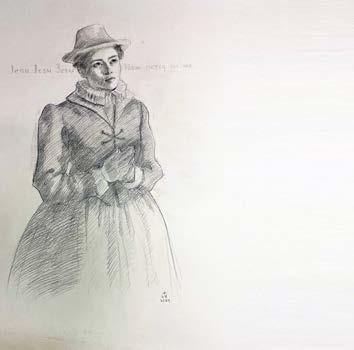
where Tyburn tree once stood. Over the years I’ve had the chance to paint Saints John Fisher, Thomas More, Edmund Campion, and Robert Southwell. Now as a wife and mother I feel a special kinship with St Margaret Clitherow. I was grateful that an English mother of five from my parish agreed to model for the watercolour.
During my pilgrimage in England, the great Michael Davies was one of our tour guides. His strength and magnetic joy have always epitomized for me the Welsh soul. I thought of him especially while painting my not-quite-namesake St Richard Gwyn. Though I couldn’t find a Welshman, I did find a Richard to model—and one who had fond
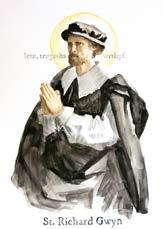
memories of growing up hearing Masses organised by the Latin Mass Society.
My model for St Tarcisius was an altar boy from my local ICKSP parish with a good Roman pedigree. The new image of St Tarcisius will be revealed in due course. I hope these watercolours of your heavenly patrons will remind you to seek their intercession and help you to imitate them in raising your minds and hearts to God.
Gwyneth (née Holston) ThompsonBriggs is a painter, mostly of sacred subjects, who lives in St. Louis, Missouri, withherhusbandandfoursmallchildren. More of her paintings may be viewed at GwynethThompsonBriggs.com
GwynethThompson-Briggs’ Margaret Clitherow study and Richard Gwyn holy card
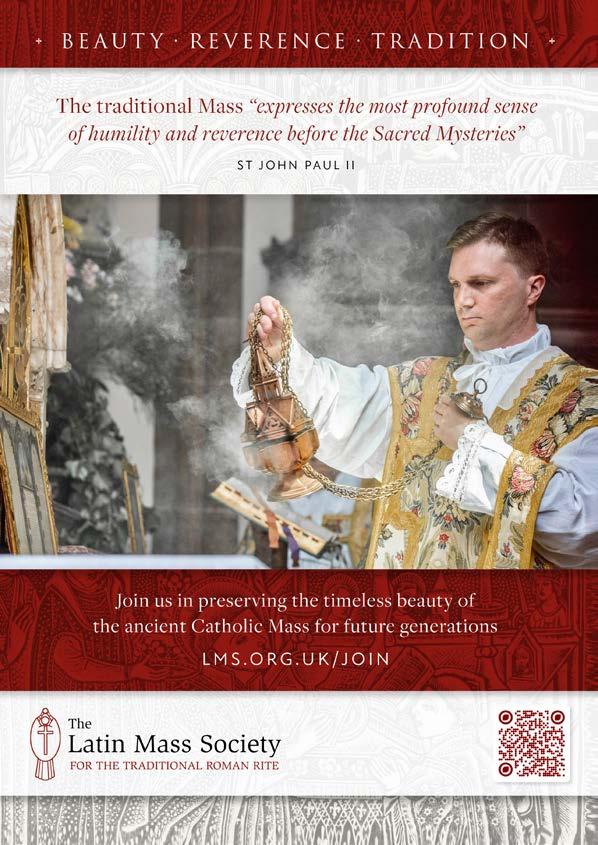
World News
Chartres Pilgrimage: Paul Waddington reports from France
Catholics around the world are becoming increasingly aware of the great pilgrimage that takes place in France each year over the Pentecost weekend. Known as the Pèlerinage de Chrétienté, it was founded in 1983 and involves the arduous walk from Paris to the Cathedral of Notre Dame de Chartres, a distance of around 60 miles. Although the majority of the pilgrims are French, many other nationalities are represented, with participants coming from as far as Australia and New Zealand.
This year, in order to comply with the requirements of the local police, the organisers had to limit the number of pilgrims to 19,000. The clamour for places was so great that the computer systems handling the bookings crashed soon after they opened, and when they were eventually made to work, the event was sold out in days. Although the pilgrimage is open to all ages, its appeal is mostly to the young, with the average age of participants this year being 20.
In recent years, the Chartres Pilgrimage has started with Mass at the Eglise Saint-Sulpice in Paris, and ended with Mass at Chartres Cathedral. Naturally, at these venues, only a small proportion of the pilgrims are able to hear the Mass inside these buildings, the vast majority having to be content with following it on screens erected outside. On Whit Sunday, Mass is offered in the open near the campsite. This year, the Whit Sunday Mass was offered by Bishop Athanasius Schneider before a congregation of about 20,000.
All Masses are offered according to the traditional rite, and conducted with great reverence and solemnity. This year, more than 200 priests took part

in the pilgrimage, and were available to hear confessions, which mostly took place on the move as the pilgrims walked.
Chartres has been a place of pilgrimage since medieval times, gaining great popularity in the twelfth century, when the present building was erected. Pilgrims flocked to Chartres to see the Sancta Camisa. This holy relic is believed to be the veil or shawl used by Our Lady to wrap the infant Jesus.
The story behind this relic dates back to the fifth century when it was sealed in a reliquary, and transferred from Jerusalem to Constantinople, where it was kept in a basilica dedicated to the Mother of God. According to some reports, the reliquary was brought to Chartres in 876 by King Charles the Bald, the grandson of Charlemagne, where it remained unopened until 1712. In that year, the reliquary was opened revealing two pieces of cloth, one of silk and the other of linen embroidered with silk.
Following the French Revolution, Chartres declined as a place of pilgrimage, but was revived in a modest way in the early years of the twentieth century. In 1984, the strongly traditionist movement, Chrétienté Solidarité, established a walking
pilgrimage from Paris to Chartres, which grew to become the Chartres Pilgrimage we now know.
With the number of pilgrims wishing to take part expected to continue to rise, the organisers are planning for a much larger pilgrimage next year. This will be achieved by dividing it into two columns that will take separate routes. That way, it should be possible to accept as many as 30,000 pilgrims.
Also from France, we have news of a boom in adult baptisms. According to figures published by the French Bishops’ Conference, 10,384 adults were baptised into the Catholic Church at Easter, 46 percent more than the previous year. As the chart shows, adult baptisms have been steadily increasing in France since the Covid pandemic, with the figure for 2025 standing at almost two and a half times the preCovid average.
Additionally, 7,400 young people, aged between 11 and 17 were baptised in France at Easter.
Other reports paint a similar picture in the USA, Canada, Australia, Austria and Belgium. It seems that interest in the Chartres Pilgrimage is, at least to some degree, a reflection of an increase in Catholicism among young people.
Chartres pilgrims

A martyr of Christ the King
Fr Crean remembers Edmund of East Anglia
This year sees the 100th anniversary of the institution of the feast of Christ the King, and also, not coincidentally, the 1700th anniversary of the definition of the true divinity of the Son of God at the Council of Nicaea. It’s often said that Pius XI placed this new feast on the calendar in 1925 because he was concerned by the rise of fascism in Italy, and wished to place before men’s eyes the true model for earthly rulers to follow: Christ reigning in humility, and from the Cross. While this may be correct, it is not quite the reason he himself gave in Quas primas, the letter by which he promulgated this liturgical celebration of our Lord’s kingship. Here, the pope simply says that the feast will be an excellent remedy for a contemporary social plague, which he designates by the Latin word laicismus. Sometimes translated ‘anti-clericalism’, the term might be better rendered as ‘secularism’. Mankind has the duty, Pius explained, to recognise Christ’s authority, as God made man, over both private and public matters.
It so happens that the ancient patron saint of England, Edmund of East Anglia, illustrates this Christian principle. King in East Anglia during the 9th century, his martyrdom is one of the most interesting, as well as one of the most moving, events in the history of the English Church. While we know next to nothing of his earlier life, we possess a vivid account of his death in 869, one written down in the lifetime of men who had been able to speak to eye-witnesses.
Let’s first recall the circumstances of that year. The various kingdoms in England, like many other realms of Christendom, were being ravaged by Vikings, who at that time were still fully pagan: the English referred to their enemies simply as ‘the great heathen army’. The victory of Alfred at Ethandune, which would turn the tide in favour of the Christians, lay nine years in the future.
The heathen army had been killing and pillaging in Northumbria and Mercia; the following year they would turn their attention to Wessex. But they had decided, before heading west, to winter in East Anglia. Under the leadership of their king Hinguar, they took up their quarters in Thetford.
Hinguar knew that Edmund was the local ruler, but rather than go into battle against him, he sent him a message, inviting him to abdicate. Perhaps Hinguar wished to spare himself and his men the trouble of another campaign; even Vikings, no doubt, sometimes need to rest. But probably he just wished to humiliate his Christian adversary. He knew that Edmund had already lost many of his men, slain in their own homes by marauding Vikings, and that it was impossible for the Christian king to put into the field a body of soldiers who could even begin to stand up against the invader.
The message that Hinguar sent may surprise us, since, at least as it has come down to us, it is surprisingly politic.
The chronicler writes thus:
Then came the messenger to King Edmund and quickly delivered the message of Hinguar to him: “Hinguar our king, brave and victorious on sea and land, has power over many peoples and now has come suddenly with the army here to this land so that he may have here winter quarters. He commands you quickly to share your hidden hoards of gold and the wealth of your ancestors with him, and you be his under-king, if you wish to be alive, because you do not have the power that you can withstand him.”
Notice that the heathen king doesn’t tell the Christian one that he will certainly be killed, like so many of his subjects; nor that he will become a
beggar, or an exile. Nor does he directly bid him renounce his faith in Christ. He actually invites St Edmund to carry on as he is, still governing, only now as subject to the Viking suzerainty: “You be his under-king, if you wish to be alive.”
The chronicler goes on:
Lo, then King Edmund summoned a bishop who was his secretary, and considered with him how he ought to answer the fierce Hinguar. Then the bishop was afraid because of the sudden misfortune and for the life of the king, and he said that it seemed advisable to him that the king submit to that which Hinguar commanded. Then the king fell silent and looked at the earth.
How vivid it is: the young king –maybe about twenty-eight – uncertain what to do, and calling on the wisdom of his ghostly father; this bishop, with a worldly prudence that may not altogether surprise us, advising him to come to terms; the young man troubled by the advice yet not wishing to contradict it, and looking down at the ground.
But note also that what galls the king is the prospect not just of losing his independence, but of having to receive again from a heathen what he has already received from God. For according to the Passion of St Edmund written in the 10th century by Abbo of Fleury from information received from King Athelstan, Edmund at this crisis called to mind the promise he had made when anointed king, that he would rule for his people’s good under Christ alone. “Shall I now begin to serve two masters?”, he asks the bishop. Then, turning to the Viking ambassador, he declares: “Go now very quickly and say to your cruel lord, ‘Edmund will never yield to Hinguar alive, to the heathen commander, unless he first submits with faith to Christ the Saviour in this land’.”
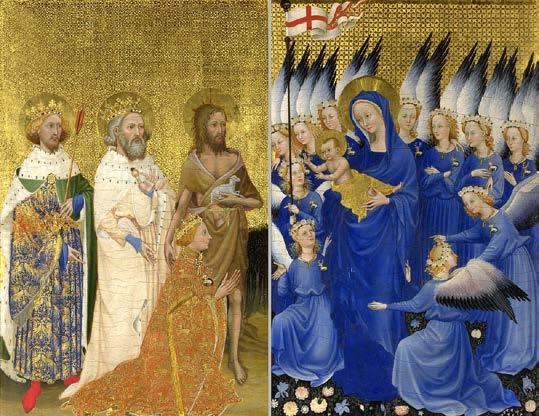
When Hinguar came with his men, Edmund put up no resistance, wishing, the chronicler says, to imitate the example of Christ, who forbade Peter to fight those who arrested Him. Like his Master, St Edmund was scourged, confessing his faith the while; then he was pierced with many arrows, and finally beheaded. Though the Vikings cast his head into the thickest part of a forest, the Christians found it with miraculous help and hastily buried it with the body.
To quote the chronicler once more
After a time, after many years, when the harrying ceased and peace was given to the afflicted folk, they joined together and splendidly made a church for the holy one, because there were frequently wonders at his grave. They wished then to carry the holy body with public honour and to lay it within
the church. Then was the great wonder, that he was just as whole as if he were alive, with a clean body, and his neck healed, that before was cut through, and there was as it were a red silken thread about his neck, as a sign to men of how he was slain. His body shows to us, which lies undecayed, that he lived here without wantonness and did with a clean life travel to Christ.
Thirty years after his death, the Vikings of East Anglia, now Catholics, started to venerate him and even to mint coins in his honour. In 1020, Canute, the Danish king of England, built an abbey at Bury St Edmund’s offering his own crown to the shrine in atonement for the crimes of his forebears.
What makes this a deeply interesting, as well as a moving story, is that the point of faith for which St Edmund dies is one that will hardly be articulated in set terms until about a
thousand years later. Had Edmund, an anointed ruler, renounced his rights in order to receive them again from a pagan, he would have been professing that Hinguar rather than Jesus Christ was the true king in East Anglia. By refusing this lie, he died a martyr for ‘the social kingship of Christ’: what Pius XI described as the right of our Lord to rule over societies as well as over individuals.
We today may sometimes feel ourselves confronted with a great heathen army that is less brutal but hardly less effective than the one wintering in Thetford in 869. If so, we can take heart from the story of the young king Edmund. Not only because his life is, as the poet says, ‘a symbol perfected in death’, but also because he is now living in glory, and interceding for the Church in this land. May he assist us to avoid all unworthy compromises and so, ‘with a clean life travel to Christ’.
St Edmund King and Martyr (far left) from the late 14th centuryWilton Diptych
A dazzling list
Mary O’Regan on the Saints of 23 September

Even though I spent eight years writing a book on Padre Pio, I must confess that before researching this piece, I was largely ignorant of the saints who share his feast day, 23 September. Now, my understanding is that a dazzling list of saints shares this day! Pio holds it because he died on this day.
The same day as Pope St Linus, who was our second Pope. He is mentioned by St Paul in 2nd Timothy 4. Reportedly, he was ordained by Pope St Peter, and they are buried next to each other.
Aspects of his biography are a matter of debate, but a certain fact is that he is listed among the Popes in the Canon of the Mass, and he was the Pope who decreed that all women have their hair veiled at the divine services. His charisms were extraordinary; he could raise the dead and drive out evil spirits. Here’s where he got into hot water. Linus exorcised the daughter of a devious consul, Saturnius, who instead of being thankful, had Linus’s head chopped off. But as I say, Linus is most remembered for ordering that women cover their heads, and perhaps us ladies who go under-cover might put our all head-coverings (be they hats or bonnets) under his protection.
If Linus came in for special mention by St Paul, St Thecla was actually converted and became a virgin for Christ after she heard Paul preach. She, too, went to her Spouse on 23 September, around the year 100, about 21 years after Linus had passed. So she was an immediate beneficiary of his papacy, and I bet she kept her locks covered at Mass, too. When she became a Christian, she was thrown out of home by her family. That’s not all – when she refused to marry the suitor they had in mind for her – they tried to burn her to death. Her family certainly don’t sound pleasant. The pyre, however, was put out by a sudden shower of rain just as Thecla was about to leap in with abandon as she made the sign of the Cross.
Miracles
She escaped to Antioch, and her faith got her in trouble again, but she also survived an attack of bulls with their fierce horns. And a sojourn in a deadly snake pit. When they witnessed these miracles, several were converted on the spot, even though they had seen with their own eyes that which could befall them. Then she became a hermit on the side of a hill where she lived out the rest of her days.
Thecla is considered a martyr because she was one in her conscience and in her intention to die. She is invoked in the rites for the dying and in the official prayer for a departing soul: ‘As Thou didst deliver the holy virgin and martyr Thecla from three most gruesome torments, so deliver the soul of this Thy servant; and let him/her enjoy with Thee the blessings of heaven. Amen.’
Blessed
Jumping ahead many centuries, in 1588 there is Blessed William Way who perished also on the 23rd. William was born in Exeter, but was a seminarian in France because the Faith was illegal on English soil. He returned to England where he was a recusant Catholic priest in the time of Elizabeth I; those details alone send a shiver down the spine and foreshadow his gruesome death. He was caught and ordered to be hanged, drawn and quartered. But he went to his death flooded with joy. His dead body was then drawn through the streets to howls and jeers.
Pio, I never knew until now you were in such good company! Ss Linus, Thecla, Blessed William Way, Pio, pray for us, and a happy feast everyone.
‘She is invoked in the rites for the dying and in the official prayer for a departing soul’
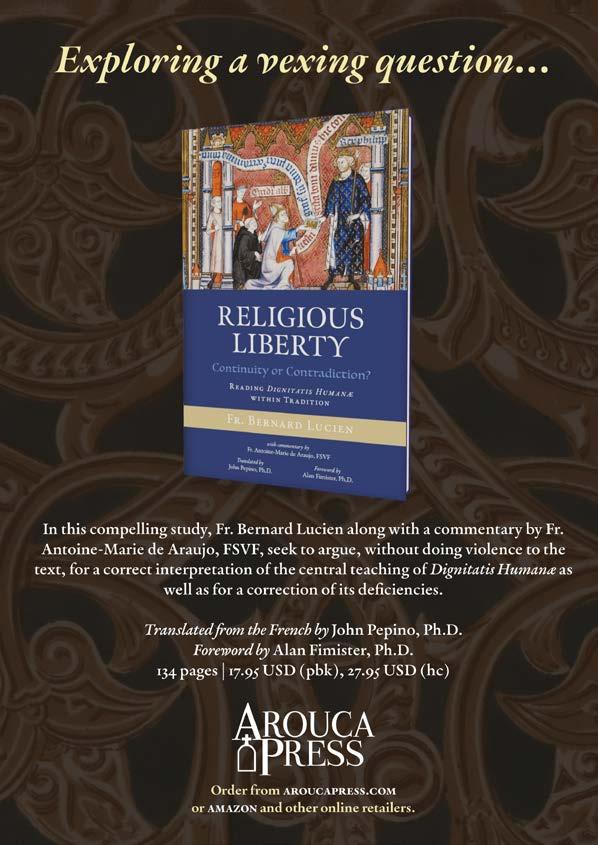
The wisdom of the theologian
Will Leo XIV embrace Benedict’s spirit of the liturgy, asks Dr Fredrick Wolf
‘...there must be no innovations unless the good of the Church genuinely and certainly requires them, and care must be taken that any new form adopted should in some way grow organically from forms already existing’
– Second Vatican Council’s Constitution on the Sacred Liturgy, Sacrosanctum Concilium.
While praised in many circles for his ‘discretion’ and diplomatic character, Pope Leo XIV’s theological positions on many subjects remain largely unknown. Francis was elected on a mandate of reform; Leo received the Fisherman’s ring to continue reform but foster unity and communion in a polarized and fractured Church. Will the new pontiff accomplish this through the modernising orientation of his predecessor or will he embrace the wisdom of the theologian, Benedict XVI? After all, they both ultimately desire the same for the Church – unity and communion. The theologian seeks it through continuity with previous church councils – let’s pray the new pontiff does as well. There are unconfirmed reports that he privately celebrated the Traditional Latin Mass.
The work of Benedict and his pontificate is generally not well understood. And this is particularly true with his post-Vatican II reform efforts. These centre on changing how we understand the liturgies and the ambience experienced with their celebration. In effect, Benedict calls for a ‘new liturgical movement’.
This article will illustrate Benedict's approach to the challenges facing the Church – which some attribute to the promulgations of Vatican II. Joseph Ratzinger’s response was otherwise – advocating, instead, a ‘reform of the reform’.
Will Leo embrace continuity in the context of Francis’ modernising legacy or as Benedict sought with his hermeneutic of continuity with Vatican I and II? This could define the pontificate of Leo XIV.
Reforming the Reform
The crux of Benedict’s response to the issues confronting the Church (and now Leo) is his hermeneutic of understanding of the Second Vatican Council. If the Council is viewed as a break with the Church’s past, then the new reformed liturgy is seen as a break with the pre-Vatican II liturgy – a ‘hermeneutic of discontinuity.’
If the Council is seen in substantial continuity with tradition, then the reforms which it promulgated must be in continuity with the older form of the liturgy – a ‘hermeneutic of continuity.’
Benedict asserts that, paradoxically, a minority of traditionalists and most modern liberals appear to make the same mistake: both view the Council as a break with tradition. He emphasized that the Council did not represent a discontinuity; rather, it expressed continuity with the Church’s history.
If one looks at the Council as the genesis of something new, then understanding the liturgy as a newlycreated entity that – evolves with the culture – elicits a ‘hermeneutic of discontinuity’ – a break with the past. Conversely, a ‘hermeneutic of continuity’ understands the liturgy as truth transmitted through tradition with the Church possessing no authority to manipulate or distort it. Changes are appropriate, but only when consistent with prior Councils, Scripture and the Magisterium of the Church.
It is untenable for the Church to have, as it were, two hearts: one lifted up to God, the other turned away. ‘Come not unto Him with a double heart’ (Ecclesiasticus 1:28). By analogy with
James 1:8, the Church cannot be ‘doubleminded’ and thus ‘unstable’. Through the hermeneutic of continuity, Benedict's efforts at ‘reforming the reform’ has meaningful purpose. Contrary to some who misconstrue his intent, Benedict's reform centers on helping us properly understand the liturgy, its purpose and meaning for us and the spiritual ambience surrounding its celebration. It does not mean we reject the Novus Ordo; rather, Benedict wants us to understand the purpose behind it – an appeal for unity and reconciliation – however misguided its distorted, overzealous implementation. It is in this context that Benedict initiates his call for a new liturgical movement: ‘…a movement toward the liturgy and toward the right way of celebrating the liturgy, inwardly and outwardly.”
Benedict initially seeks to quell innovation as the primary thrust in the liturgy. With this Pope the liturgy should be centered on God – and nothing else. Rather than a liturgy celebrated with the celebrant facing the people, Benedict encourages celebration ad orientem (towards the East) – a Christological orientation. This gesture of priest and faithful pivoting in unison towards Christ underpins an understanding of the liturgy and our lives as being towards God. At the same time, it undermines the idea of a ‘human-centered’ ritual, all too frequent in today's Church.
The issue of orientation in the liturgy, Benedict asserts, should be combined with some Latin in the Ordinary Form. He understands that the ‘Liturgy of the Word’ is usefully addressed in the vernacular, but the use
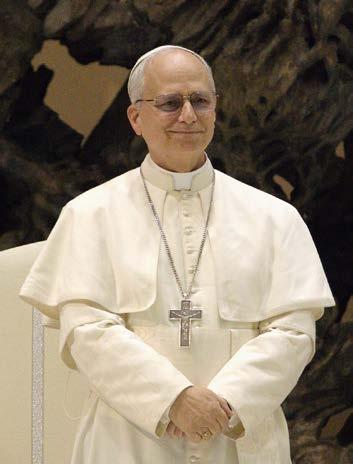
‘Let us pray that Leo XIV pursues unity and communion’
of Latin in other areas of the Mass would bespeak the catholic (universal) nature of the Church’s Extraordinary Form –continuing its tradition. The idea is to contribute to the mutual enrichment of both forms which Benedict spoke of in the motu proprio Summorum Pontificum.
The final component of Benedict’s liturgical reform is the idea he made manifest as Pope through his Summorum Pontificum. The promulgation allowed a more expansive use of the Tridentine Mass which, he believed, would offer tangible benefits towards unity in the Church.
This Pope’s intent was to reconcile the Church with those troubled by certain of its ‘experimental innovations’ because of liturgical or other concerns, as with
the
Society of St Pius X. Use of the older form of the Mass, the Pope believed, would also help maintain continuity between Vatican II and its antecedents.
Liturgical Renewal
As Pope, Benedict (the former professor of theology) emphasized his role as educator, rather than inculcating structural reforms into the liturgy. His teaching revealed themes present throughout his ministry – a liturgy with God at its center; the nature of the liturgy as a conveyance of established truth; the transcendent dimensions of the liturgy.
For Benedict, it is not about changing the rites again (this would redouble the mistakes of the last six decades); rather, he wanted to change how we experience the liturgy – and allow it to change us.
This Pope did not simply want to restore the past ad orientem practice, but to institute reform in continuity with the past. He does not advocate that the entire Mass be celebrated ad orientem; rather, only a portion – the Eucharistic liturgy proper – where the priest leads the faithful to turn towards God, in unity and communion.
Reform of the Reform – an error?
As much as Benedict advocated reforms consistent with but not beyond Vatican II promulgations, Pope Francis’s disinterest in the content, spirit and intent of the Second Vatican Council’s Sacrosanctum Concilium was glaring. The Pope referred to Benedict’s efforts disparagingly (before his death) saying: ‘to speak of “the reform of the reform” is an error!’.
Yet, in spite of Francis’s liberal agenda, Benedict the theologian defends the Council's actual promulgations – not the radical extremes and hyperbole that overzealous modern liberals have imposed upon the Church faithful.
Benedict asserts that Vatican II promulgations were not a break with previous Church teaching regarding Vatican I and before; the Church, by her very nature, cannot break with her own past. To suggest that previous teachings were flawed, and we are just now ‘setting them straight,’ is to deny that the Church is and always has been guided by the Holy Spirit.
To understand that the Church remains under the continual guidance of the Holy Spirit, is to understand the validity of Vatican I and II. To do otherwise is to forsake Christ's words in Matthew 16:18-19, the apostolicity and catholicity of the office of the Pope and to our great detriment – the very nature of the Church, itself.
This writer believes Pope Benedict XVI hoped we would see his own contributions less in terms of his concrete proposals and more (as he wrote in his book – The Spirit of the Liturgy) as a retrieval of the latter – and its central role in the life of the Church as well as our own lives.
Let us pray that Leo XIV pursues unity and communion through the wisdom of this profoundly Catholic Pope, Benedict XVI, by following a ‘hermeneutic of continuity’ allowing the traditional liturgy and timeless sacraments of Christ's Church to manifest in us through sanctification – similitudo Dei –the likeness of God.
Finally redeemed
Sebastian Morello on the delights of Gordon’s Morello Cherry Gin
As a rule, I do not review distilled spirits. Hitherto, I have mostly sought to keep away from them altogether. Distilled spirits are dangerous substances. We should take note of the fact that the distillation process was introduced to the West and its presence has played merry hell with Christian nations. There is much virtue and little danger in fermented libations, but in distilled tinctures the danger is acute. I have seen the most genteel of men turn savage under the influence of a few drams.
Nonetheless, it must be admitted that the monastic alchemists and herbalists of the high Middle Ages put this new knowledge to good use. Hooded masters of hidden lore took God’s benignity woven into His creation and concentrated it in fiery potions, restoring health to God’s faithful by way of His botanical gifts. Indeed, it is on account of this pharmaceutical heritage that distilled spirits gained their ancient name: aqua vitae, the ‘water of life’.
Only when that libidinous ogre Harry VIII smashed the monasteries of these sacred Isles did distillation leave the cloister and enter the tavern. Homeless monks wandered the land, selling their ethanol and the knowledge of its production, in the hope of making ends meet. But only after the Inglorious Usurpation of 1688 did the political use of distilled spirits occur to our overlords. In a desperate attempt to make the English forget Merry England, whose innocent playfulness and piety the Stuarts had sought to restore against the wishes of treasonous Puritans, William of Orange drugged the nation with gin.
Since the toppling of the Stuarts, gin has haunted our country. I recall, over two decades ago, admiring the signet ring of a school chum as we rested on the grass after a rugby game. On his signet was the profile of a boar’s head. “Don’t you recognise it?” he asked, “It’s on all our bottles”. His surname was Gordon. I took little notice, and only years later did I observe the same chivalric hog of my armigerous schoolfriend on a bottle

of Gordon’s London Dry. Not until early adulthood did I learn of gin’s noxious, Protestant history, and only after I had acquired a liking for the stuff while replenishing myself with G&Ts on safari in deepest Africa.
At our camp on the Zambian side of the Zambezi River, near Victoria Falls, I remember my brother ordering a ‘Pink G&T’ (1 part gin, 2 parts tonic water, and a few drops of Angostura bitters). A gentleman was perched at the bar; he was dressed from head to toe in bush khaki, and under his wide-brimmed suede adventurer hat, his rosy face was straddled by an enormous Kitchener moustache. He registered his appreciation of my brother’s judicious cocktail order: “Excellent choice!” he exclaimed, “the quinine in the tonic will deal with any malaria, and the bitters will bestow upon your skin a scent that will keep the mozzies at bay in the first place”.
“And the gin? What’s that for?” asked my brother.
“That, my dear chap,” said the gentlemen, leaning in, as if telling a secret, “Is to make you blotto.”
You see, gin’s malignant purpose cannot be hidden for long. And yet, by some tendentious and highly dubious causal chain, we might argue that gin has finally been redeemed. For not only is gin a child of those distilled potions effected by the sacred art of medieval monks, but alone it has maintained a connection with the ancient monastic discipline of curative herbalism.
Gin derives its complex flavours from a host of botanicals, all at the service of the dominant juniper berry. Since severance from its monastic patrimony, gin has been redeemed by the creation of Gilbey’s Gin in the 19th century, by Sir Walter Gilbey, the uncle of the great Monsignor Alfred Gilbey. We are told that God brings good out of evil, and behold: out of a family of gin-makers the Church received one of its most loyal defenders of her holy Tradition. You may certainly raise a cold G&T to that!
By diluting a distilled spirit, one mitigates the peril. Following the invasion of William of Orange, the mournful English used to drink gin neat and - I kid you not - in pints. Fortunately, those days are over. Gin is best taken 1:4 or 1:3 with tonic water and a few ice cubes, either in a highball glass or, as has become trendy in recent times, in a Spanish balloon glass (which has been re-marketed as a “gin balloon”).
A G&T cocktail is, in my view, an instance of gin redeemed, salvaged from its injurious past. All that was needed to improve this classic colonial concoction was admixture with morello cherry. Well, you’re in luck, for Gordon’s has released a Morello Gin! Gin, we might say, has been liberated from Orange and salvaged by Cherry! And a Morello G&T is, it turns out, the perfect accompaniment to late summer evenings, as I have repeatedly confirmed over the past months. Enjoy!
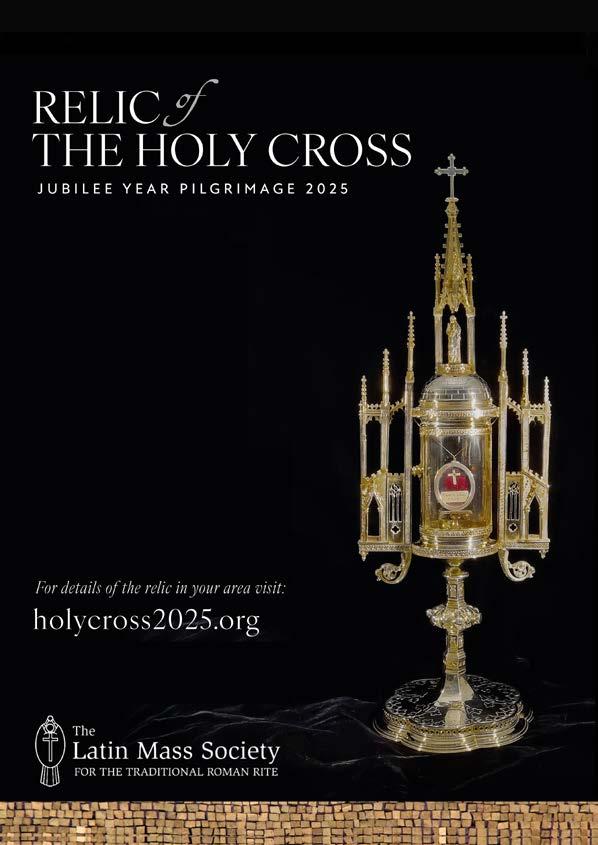
BIRMINGHAM: 25-28 July
CHELMSFORD: 1 August
STANSTED MOUNTFITCHET: 3 August
CHELMSFORD: 10 August
BARKING: 10 August
CANNING TOWN: 10 August
HUTTON: 14 August
WITHERMARSH GREEN: 15 August
IPSWICH: 18 August
WALSINGHAM: 24 August
LONDON: 15-16 September
CHIDEOCK: 20 September
LANHERNE: 21 September
EXETER: 27-28 September
PLYMOUTH: 4 October
CREDITON: 5 October
BEDFORD: 1 November
NEW BRIGHTON: 2 November
OXFORD: 5-8 November
AND MORE
Ad multos annos to the Latin Mass Society!
Bishop Athanasius Schneider visited England in June to take part in the Latin Mass Society’s Faith and Culture Conference and Holy Cross Pilgrimage, both held as part of the Society’s sixtieth anniversary celebrations.
During a six-day visit coinciding with the Octave of Pentecost, His Excellency celebrated Solemn Pontifical Masses at Northampton Cathedral, St William of York in Reading, and the Shrine of St Augustine in Ramsgate. He also presided at Solemn Pontifical Vespers at the London Oratory, a service held in connection with the Faith and Culture Conference at which he spoke on The joy of our Catholic faith. Each liturgical celebration concluded with singing of the Vexilla Regis and Benediction with the relic of the True Cross which is touring England and Wales in the Holy Cross Pilgrimage.
At a dinner held in Bishop Schneider’s honour at the Rembrandt Hotel—the very place where the Latin Mass Society was founded in 1965—he praised the Society’s work in safeguarding the Church’s liturgical tradition and offered his heartfelt wishes for its continued flourishing over the next sixty years.
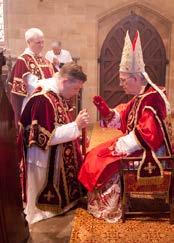
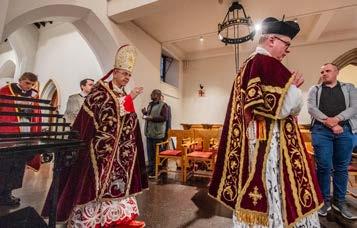
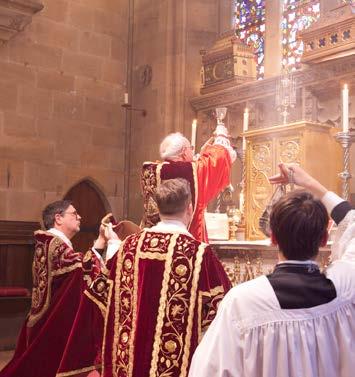
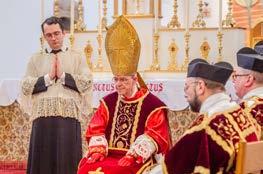
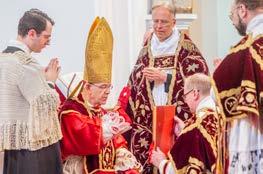
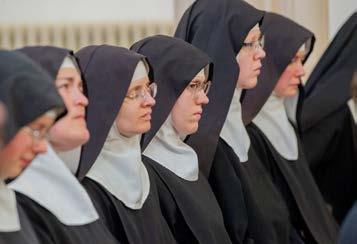
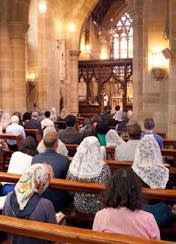
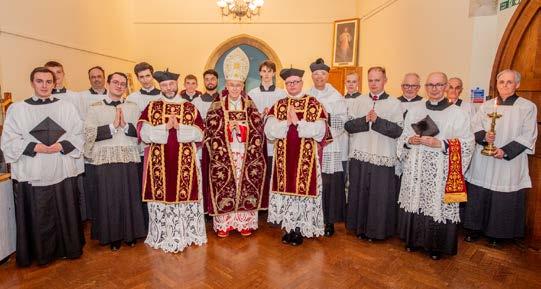


It may be sooner than you think…
James Preece on mortality
This morning, I passed the post office on my way home to lunch where my wife passed me the salt. I hope my daughter has passed her exams or she may be passed over for a place at university. What a lot of uses for ‘passed’ we have! In April this year my father ‘passed’; that was how the funeral director put it. People were sorry about his passing. Some may have gone so far as to say he had ‘passed on, but nobody seemed willing to simply say: James, your Dad is dead.
I understand that people mean well and the intention was to avoid hurting my feelings - I would probably use similar language if speaking to somebody who might be going through a difficult time and not in the mood for a Monty-Python sketch. This Dad is dead, he has ceased to be, is bereft of life, shuffled off ’is mortal coil, etc. Still, it seems a strange quirk of our post-Christian culture that we are so proud to have left superstition behind, yet we are unable to speak openly about something so commonplace as death.
The general reaction seems to be one of surprise - as though we did not know all along that death was coming! Perhaps I am a little morbid, but whenever I visit an old Church or Cathedral I’m always drawn towards the gravestones or paintings with skulls on: ‘What we are, you will be,’ reads the inscription. Memento mori. Remember you will die. It’s a timely reminder - a spoiler alert if you will. Every single one of us, everybody we love, will someday be dead.
It may be sooner than you think. A couple of years ago I turned forty and was told by many well-meaning acquaintances that ‘you are still young’. They mean well but they are wrong - I know this because I have recently been learning to skateboard and the difference between a young body and an old one is immediately obvious the moment one throws oneself down a ramp on to some
concrete. How quickly the ‘you are still young’ people became the ‘you are too old for that’ people.
Learning to skateboard at my age is generally characterised as a midlife crisis and perhaps it is. Yet what is a midlife crisis but radical action taken in the face of one’s own mortality? If not now then when? It’s later than you think and if you are one of the many ‘young fogies’ in the Latin Mass society - you do not know the hour. If you have something in mind to do someday then I suggest you get on and do it. Ask that girl to marry you, buy that piano, have another baby, learn a language, take up a new sport.
Another strange experience around losing my father (there’s another onelosing - I didn’t lose him; he was in a box at the funeral directors); another strange experience was being asked to describe him. How do you take the full sum mystery of a human life and turn it into a few words? He was a Dad? He was an electrician? He ran a pub for a while? It all seems so insufficient. I had a similar experience once when somebody asked me what my wife was like - my mouth opened but no words came out. She’s like... She’s like... She’s like my wife. I like her, I think she’s nice.
This is why it’s important to spend time with people while we can - photographs and memories are no substitute for the real thing.
One thing I remember about my dad is he used to explain his parenting; when I was whining as children often do, he would say that parents are only human and children don’t come with an instruction manual and these are his thoughts about whatever it was. If it turned out those decisions were wrong, he was capable of doing something I have since discovered is almost a superpower: He was able to apologise to his children. Something I recommend to all parents!
As Christians we cannot speak about death without speaking about our hope of eternal life in Jesus Christ. Remember you will die, not so that you fall into despair but so you go to confession often and really live! My father was a complex man; for many years he devoted himself to his family, at other times he struggled with alcoholism and depression - but I would say most of his sins were less of the ‘premeditated evil’ and more of the ‘led into temptation’ variety.
Does that mean I think he is in heaven? It means I hope he is in heaven (or on his way) and I will pray and have Masses offered for the repose of his soul. His name was David Preece, please take a moment to pray for him and for your own loved ones who have ‘passed’.
‘As Christians we cannot speak about death without speaking about our hope of eternal life’
All God’s children
Caroline Farey discusses a painting that shows Catholic culture at its fullest
In this painting, we see Catholic culture at its fullest, manifesting the Church’s all-embracing worldview in the great, annual procession to the fields for the blessing of the harvest. Here, the wheat newly grown in the fields is visited by the wheat that has reached its highest destiny in the sacred host of the Blessed Sacrament.
Such an event was typical and widespread in Christian Europe, such as here in 19th century France in the fields of the village of Courrières, in the region of Artois, where the artist, Jules Breton, lived. Traditionally, the processions took place on the three Rogation days, which fall on the Monday, Tuesday and Wednesday before Ascension Thursday. In this painting the wheat is high and golden suggesting a blessing on the harvest just before its reaping.
Such processions supremely unite the visible world of God’s creation with God the Father’s otherwise invisible, loving care for his children, from his provision of the natural world, to man’s capacities for transforming creation by their graced labours, through to the sending of the Son of God to save, to nourish and to recapitulate the world and all its peoples to himself.
Significantly placed in the foreground, the poorer farm folk who have laboured for the wheat’s planting and growth, kneel as the priest passes by, who, by the power of the Holy Spirit, has transformed their wheat into the body of Christ, ‘panem sanctum vitæ æternæ’. All here are aware that without the work both of the farmers for the wheat and the priests for the Eucharist, we would

not have the ‘daily bread’ we need for the body and soul in this life for the next.
The faith of those kneeling in worship is, therefore, placed foremost in the painting, with a range of humble and genuine gestures for us to respect and imitate: there are hands clasped, backs bent, heads bowed and a little girl stretching out her arms towards the Beloved Eucharist.
The long, early morning shadows across the path show us that the sun is still low, having only recently risen in the East. This gives the painting a tone of early morning freshness before a full summer day ahead; just as we receive a joyful foretaste of eternity in the Eucharist before the full and everlasting day of heaven.
So, the huge procession moves through the fields before the day’s work begins for each of the different classes of society - and all classes are present.
This liturgical event, as for all Catholic liturgy, is relevant to every level of society; the processing crowds have a single purpose which gives a sense and sign of the unity and equal dignity of all God’s children, men and women, rich and poor, young and old.
Notice the many different roles of those in the procession. The Eucharist is in the centre of the painting and of the procession. Many follow behind, but many more lead in front, preparing the way for so great a participant in their midst. The people here may well be characters from the artist’s own neighbourhood, so particular are their features and his village church is seen in the background beyond the fields of Courrières where he lived.
The priest and deacons wear vestments suitable for a solemnity such as that of Corpus Christi. The deacons chant the litany of the saints and pray in remembrance of God’s promises:
Jules Breton’s The Blessing of the Wheat in Artois painted in 1857 and now held at the Musée d’Orsay, Paris
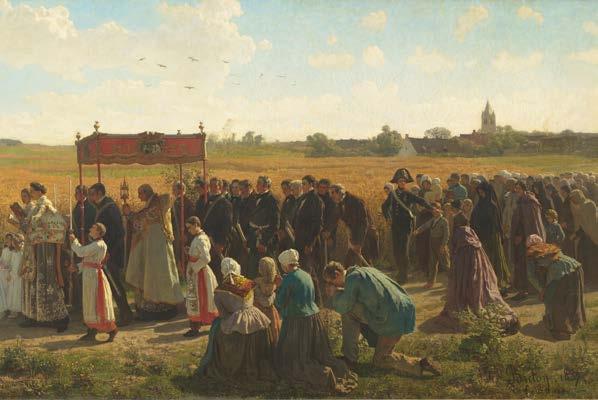
“If my people, who are called by my name, will humble themselves and pray and seek my face and turn from their wicked ways, then I will hear from heaven, and I will forgive their sin and will heal their land.” (2 Chron 7:14).
“Keep his decrees and commands, which I am giving you today, so that it may go well with you and your children after you and that you may live long in the land the Lord your God gives you...” (Deut 4:40).
Immediately in front of the deacons, little girls have baskets of petals ready to strew the way at the appropriate moment. They are preceded by lay cantors for the psalms and canticles. The young woman carrying the paschal candle, representing Christ, is in turn preceded by maidens who carry a crowned and garlanded statue of Our Lady, she who gave birth to Christ, the
“If you follow my decrees and are careful to obey my commands, I will send you rain in its season, and the ground will yield its crops and the trees their fruit.”
(Lev 26:3-4)
light of the world. Further ahead in the procession another statue is carried by nuns, also in a decorated bower. This may well be a local patron saint such as the abbess, St Bertha of Artois.
Further ahead the banners of several guilds can be seen and, right at the front, the liturgical event is headed by a processional cross visibly glinting in the sun for the whole procession to see. The processional cross is always to remind its viewers that Jesus had said,
“and I, when I am lifted up from the earth, will draw all men to myself’ (Jn 12:32).
Following the cross ‘high and lifted up’, Christ does draw all ‘those whose hearts are willing’ (Ex 25:2) towards himself and they in turn ‘lift him up’; exalting him in singing their praises with the psalms still used for Rogation days. First and foremost, however, ‘rogation’ is from ‘rogare’ to ‘ask’ or ‘appeal’.
‘We appeal to Thy graciousness, O Almighty God, that Thou wouldst shower Thy blessings upon these first fruits of creation, which Thou has nurtured with favourable weather, and mayest bring them to a fine harvest. Grant also to Thy people a sense of constant gratitude for Thy gifts, so that the hungry may find rich nourishment in the fruits of the earth, and the needy and the poor may praise Thy wondrous name. Through Christ our Lord. Amen.’
This is reality
Fr Aidan Nichols on the gifts of the Holy Spirit
We might be surprised to learn that the third panel of the Credal triptych is devoted to the Holy Spirit. At first sight when we look at the Creeds, the Holy Spirit seems to be simply the initial item in a long list of add-ons, varied if (no doubt) important extra issues that otherwise might have been forgotten.
But that first glance is misleading. Everything that follows the name of the Holy Spirit in the Creed is governed therefore by the thought of, ‘Our Lord the Spirit’ as the playwright, poet, and novelist Charles Williams loved to call the third Trinitarian Person.1 The seeming ragbag of extra issues that rounds off the Creed is in reality an account of the distinctive work of the Holy Spirit in the Church, a work that brings the work of the Son, the Second Trinitarian Person, to its completion.
When a French priest gave his book on Pneumatology the title ‘The Holy Spirit, this Unknown One’,2 he had in mind not least that there is something especially discreet about the Holy Spirit which makes his presence rather incognito. The Father is revealed in the Son and the Son becomes visible in the human nature he took in history, so that anyone who sees Jesus has seen the Father (compare John 14:9). But how for the evangelists is the Holy Spirit visible? Only at best in two or three widely separated symbolic phenomena – the descent of a dove onto the head of Christ at his Baptism in the Jordan, the bright Cloud which overshadowed Jesus at the moment of his Transfiguration on Mount Thabor, the tongues of flame seen flickering round the heads of the apostles at Pentecost.
The Russian theologian Vladimir Lossky thought that, even in the Age to Come, we shall only see the person of the Spirit in the glory on the faces of the saints. Likewise, in our lives on earth, St Paul tells the Romans (8:26) that when we do not know how to pray, the Spirit prays in us with sighs too deep for words: an underground presence, then, urging us on toward the Father even when we cannot find words with which to formulate our desire for God.
For the school of St Thomas, the Gifts of the Holy Spirit listed elsewhere by St Paul, Gifts such as ‘counsel’, ‘wisdom’, and ‘understanding’, are what explain mystical prayer, ‘hidden’ prayer. ‘Hidden’ is one of the meanings of the Greek word mystikos.
Such hiddenness reflects the Spirit’s role in the Holy Trinity. Just as the Son finds his identity in loving self-surrender to the Father, so the Spirit finds his identity in facilitating the love-exchange between the Father and the Son. He is the ‘Go-Between’ in God, and Go-Betweens don’t carry out their function properly if they draw attention to themselves rather than to those their job is to join together. Purifying and enlightening the apostles at Pentecost, the Holy Spirit did not teach them about himself. Instead, he taught them the truth about the Father and the Son, as was duly celebrated at the First Ecumenical Council, Nicaea I, in 325. It would not be until the Second Council, at Constantinople in 381, that, by a kind of afterthought, the Spirit’s own divinity was acknowledged and even then it was in tacit form.
We do not say in so many words in the Creed that the Holy Spirit is consubstantial with the Father and the Son, one unique divine substance with them. We content ourselves with saying that with Father and Son he is co-adored and co-glorified.
Yet there is also a visible work of the Spirit, and it is named in this last portion of the Creed. His visible work is the Holy Catholic Church. In Holy Church, with her (perfectly visible!) sacramental and ministerial structure, sanctifying grace and the divinely bestowed ‘virtues’ of faith, hope and charity and the Gifts of the Spirit that enable mystical communion are made available through Baptism as sealed by Confirmation. ‘Available’ but many things are available that in practice people do not avail themselves of. We are not visibly a Church of saints, and if holy Church is meant to be the visible work of the Holy Spirit that is a problem. Of course, for those Protestants who hold the Church to be essentially invisible the problem goes away. But not for us.
Here is where another perspective on the Holy Church of the Creed may be helpful. In that other perspective we call the Church the indefectibly holy Church because her ‘matrix’ at the Cross is Mary. In the way the Church came from this matrix – in the Cenacle, where Mary prayed, surrounded by the apostles – ‘she’ is essentially a Marian affair. However mediocre or even downright ghastly Church folk may be, we can still legitimately call the Church the ‘immaculate’ Church, the ‘virgin’ Church, the Church ‘our Mother’, owing to this perpetually fruitful Marian matrix. For these are all titles that we give first and foremost to the Panaghia, the all-holy Mother of God.
But Mary is not alone, thank Goodness, in manifesting the visible work of the Spirit. There is also, as the Creed goes on to say, a ‘communion of saints’. Both in Latin and in Greek that phrase can bear one or both of two senses. Communion of holy people, yes, but also communion of holy things, holy gifts, meaning by that the sacraments and above all the Holy Eucharist (for Baptism, the other chief sacrament, has its own distinct mention in the Creed of Nicaea). The ‘communion of saints’ refers to the interflow or interchange by which the members of the Church militant, suffering, and triumphant – the Church on earth, in Purgatory, and in Heaven – can pray and make satisfaction for one another. The ‘communion of the Holy Gifts’ refers to the Eucharist: so important to the interactive life of the saints that it can be called by the same name. Like the Holy Spirit at Pentecost the Mass comes from the Paschal Mystery of the death and resurrection of the Son. The Spotless Lamb offered himself to the Father once for all in the eternal Spirit and now that Spirit renders the Eucharistic Gifts identical with the glorified crucified Son in his continuing posture of intercession for us. This is the deepest meaning of transubstantiation.
1. Charles Williams, The Descent of the Dove. A Short HistoryoftheHolySpiritintheChurch (Oxford: Benediction Classics, 2017 [1939]), p. 10.
2. René Laurentin, L’Esprit-Saint,cetInconnu.Découvrir soneexperienceetsaPersonne (Paris: Fayard, 2018).
And so we come to the topic of forgiveness of sins. The Swiss mystic Adrienne von Speyr, a convert from Calvinism, called the Atonement the Saviour’s confession, made on the Cross when he confessed the sins of the world which he carried there, by way of expiation, in his own divinehuman person. And similarly, she calls the Resurrection the Father’s act of absolution: absolution not of course of the sins of Jesus, for he had none, but of that same sin of the world for which Jesus had made such abundant recompense. That ‘absolution’ is God’s act of forgiveness passed on to us in the reiteration of Baptismal grace that is found in sacramental Confession. 3
Next the resurrection of the flesh, for the Apostles Creed prefers the crude language of flesh, which we also use for sirloin steak, to the more refined language of the risen body. Like ancient Gnosticism modern eroticism underestimates the flesh because it fails to see how flesh can be the carrier of spirit, and even of the Holy Spirit. Believers in the Incarnation are not likely to make that mistake.
Our future risen flesh will be on the model of the Resurrection of the Lord which enables Christ’s relations with the disciples to be sheer communion, which not even solid walls could prevent. In the risen flesh our gestures in the body will be likewise, we must assume, more efficacious, more eloquent of personal relationship. Our bodies now are not always reliable conduits for the message our souls would send to others.
Finally, then, the Life everlasting. ‘I have come that they may have life’, says the Jesus of St John’s Gospel, ‘and have it to the full’ (John 10:10). And indeed, it all comes together in the life the Creator gives as Redeemer through the Holy Spirit, the Consummator. My ‘I’ will at last fit perfectly with the corporate ‘I’ of the Church as the Bride of Christ in her perfected beauty, one with him in the life of the new and everlasting Covenant. Heaven is that eternal life fully received, Purgatory that same life awaited in full assurance, Hell the same life known as rejected for evermore.
When we conclude the Creed by saying ‘Amen’ we mean, Yes, this is how things are. This is reality.
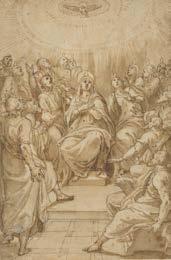

3. Adrienne von Speyr, Confession (San Francisco, CA: Ignatius Press, 1985).
There is something especially discreet about the Holy Spirit
His gentle gaze…
Edward Dundon on the remarkable history of the Veil of Manoppello
The Shroud of Turin, a wellknown piece of linen thought to be Jesus’ burial garment, has a global reputation. But there are other burial cloths linked to the passion and death of Jesus. Another is the Holy Veil of Manoppello, which also bears a miraculous image of Jesus.
The Veil of Manoppello is portrayed on a see-through fabric that measures seventeen by twenty-four centimetres and is encased in a silver reliquary. In 1999, Fr Heinrich Pfeiffer, a renowned scholar of the Holy Face (another name for the Veil of Manoppello) and professor of Art and Christian Iconography at the Gregorian University, Rome, announced that he had asserted the authenticity of the Veil of Manoppello. The Veil is now displayed on the main altar of the Capuchin Church, built in 1620. Manoppello is a town in the Abruzzi region of south-east Italy, thirty kilometres from Pescara.
There are two theories regarding the origin of the Veil. One legend says that Veronica, who suffered from severe bleeding, was healed when she touched the hem of Jesus' cloak. As Jesus carried his Cross to Calvary, Veronica, moved with sympathy, offered him a cloth to wipe his face. When he returned it to her, an image of his face was imprinted on the cloth. The other theory posits that the Veil was a small burial cloth that covered Jesus' face while he was in the tomb.
Veronica is said to have presented the Veil to the Roman emperor, Tiberius. It became known for its extraordinary healing properties, including its capacity to alleviate blindness. Referred to as the Veil of Veronica (or simply Veronica), this linen cloth is currently housed in a chapel at St Peter’s Basilica.
In 1300, the Veil of Manoppello was displayed in the Vatican and became recognised as one of the mirabilia urbis (the wonders of the city) for visiting pilgrims. The exact date and circumstances surrounding the disappearance of the Veil from Rome and its eventual arrival in Manoppello remain unknown. Some historians
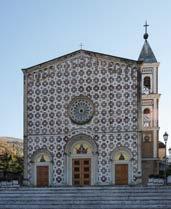
The Veil of Manoppello: ‘From 1638, the Church of St Michael safeguarded this object of veneration’
speculate that the Veil was taken from the Vatican during the reconstruction of St Peter’s Basilica in 1508, prior to Charles V's Sack of Rome in 1527. At St Peter's Basilica, only an empty frame and a shattered glass panel remain of Rome’s once-existing Veil. The Vatican hesitated to declare the loss, probably in consideration of the large number of pilgrims who then travelled to Rome.
In 1506, an anonymous pilgrim brought the Veil to Manoppello. The pilgrim gave the cloth to Dr Antonio Leonelli, a member of a distinguished family, who kept the piece of material for almost a century. Between 1618 and 1620, it was purchased by a devout supporter of the Church in Manoppello, De Fabritiis, who gave it to the Capuchins in 1638.
From 1638, the Church of St Michael safeguarded this object of veneration within a secure tabernacle. In 1714, a frame was placed around the Veil before it was transferred to the altar of the Chapel of the Blessed Virgin. The Veil was displayed twice a year for visiting pilgrims, until it was moved to its present location on the main altar.
On 13 January 1915, ten-year-old Emidio Petracca was preparing to assist morning Mass at the Church of St Michael. Suddenly, an earthquake of 7.0 magnitude struck the Abruzzi district, killing 30,000 people. Within minutes, Emidio was buried under rubble. He struggled to breathe, as dirt and debris filled his ears and mouth.
A little later, he heard a scratching sound. He saw a light and what resembled fingers making an opening that seemed to enlarge. Hands were suddenly pushing rocks and rubble aside. ‘Help me,’ Emidio said. ‘I’m coming,’ said the man. In a few seconds, Emidio could see the face of his rescuer. He had long brown hair, a short beard and dark eyes. His face was the picture of virtue. ‘You will not die. You will do great deeds,’ the man said. In seconds, he disappeared.
The prediction came true. Emidio entered the Capuchin order in 1922 and he was ordained priest in 1931. He took the name Domenico da Cese. He seldom spoke about his miraculous escape, but he always wondered about his mysterious lifesaver. The picture of the man’s face remained constantly in his thoughts.
In 1966, Domenico went on a pilgrimage to the Church of St Michael, Manoppello. On his arrival, he was taken to see the Holy Face. He had heard much about the miraculous relic there, which many believed to be the cloth placed upon Jesus' face when he was buried.
In the Church of St Michael, the reliquary was positioned high on the main altar, a place it had occupied since 1923. Domenico stared at the image. The face appeared to glare at him. Domenico gripped the railings for support. It was the image of the man with the long hair and short beard who had rescued him fifty years before. His gentle gaze seemed to penetrate Domenico's heart.
After seeing the Holy Face, Domenico wanted to be permanently assigned to it. His devotion was so strong that his superiors granted his wish to stay in Manoppello. Soon he became known as the First Apostle of the Holy Face.
Domenico maintained that the cloth was a most precious relic that was woven with an image of Jesus, whose eyes were open and his wounds were healing. The Veil that had covered Jesus' head was one of the cloths mentioned in the Gospel, which Peter and John saw in the tomb. Domenico’s research then concentrated on the comparison of the Holy Face with the Shroud of Turin. Both cloths featured the image of a man – one living and one dead. He worked tirelessly, teaching that the Holy Face seen was the Risen Christ.
In 1978, the Shroud of Turin was on exhibition at Turin and Domenico decided to take the opportunity to see the Shroud for himself. On September 13, 1978, he travelled to Turin. When crossing the road and pondering on the difference between the two images, Domenico was struck by a speeding car. Knocked to the ground, he suffered bleeding from a head injury and had broken ribs. From his hospital bed, he said: ‘It is an offer from the Shroud of Turin.’ He forgave the driver of the car. On 17 September, he passed to his eternal reward. His final words were: ‘Venerate the sudarium of Christ.’
Sixty priests attended Fr Domenico’s funeral Mass officiated by the Bishop of Chieti, a city in Southern Italy. He is buried in the family tomb in Cese, a city in Abruzzi, Italy. The Cause for his holiness was opened in 2013. In 2015, Fr Domenico was declared a Servant of God (the first step towards canonisation).
After almost six decades, the Veil remains a topic of extensive debate and discussion. Although scientific specialists are unable to explain the source of the Veil, they agree on one fact: like the image of the Shroud of Turin, the Holy Face was not made by human hands.
The Holy Face has been subjected to the same examination techniques that were used to examine the Shroud of Turin. Experts affirm that modern science cannot explain the genesis of the Holy Face, nor the unusual shades that give it a luminous appearance.
According to Professor Vittori of the University of Bari, Italy, the Veil is not an oil painting as no residual deposits of colour have settled into the gaps between the fibres of the cloth. Neither is it a watercolour because of the clear outlines of the eyes and mouth. The most striking feature is its transparency. The Veil is perfectly visible from either side, not unlike a photographic slide. It is invisible under a bright light. Under fluorescent light, the delicate fabric is of a honey-gold texture.
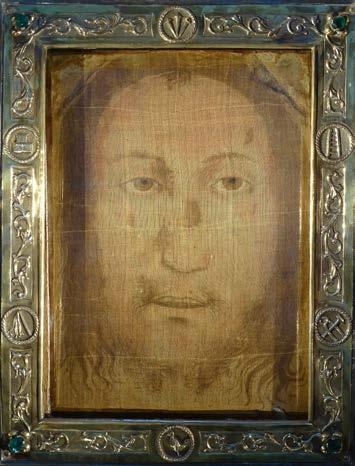
Based on the expertise of Professor Portoghesi, an authority in firstcentury textiles, the fabric is made of marine byssus sea-silk, which is resistant to dyes. It is not possible to paint on this delicate material, which is mentioned in the Bible and found in the tombs of Egyptian pharaohs and was considered one of the most expensive materials in ancient times.
Dr C Vigo, a world expert in byssus linens, states that the fabric is woven out of silk threads spun by a sea mussel.
After years of meticulous research, many experts, including iconographer Sister Blandina Paschalis Schlomer, a German Cistercian nun, have concluded that the face of the Shroud of Turin and the Veil of Manoppello represent the same person.
Cardinal Joachim Meisner, Archbishop of Cologne (1933–2017), said of the Veil: ‘. . the so-called Face of Manoppello perfectly overlays the image imprinted on the Shroud of Turin. Yet whereas in Turin the face appears in torment, the face in Manoppello – while perfectly matching the image of Turin – reveals all the power of the Easter victory.’
The image of the Veil was not caused by contact between body and cloth. It was an act of divine intervention. The Shroud of Turin shows Jesus' deceased body, while the Veil, though unglorified, displays an imprint of his living face, beyond which the splendour of the resurrected Christ is unimaginable. We can only behold it in its full glory in heaven.
The Veil is now displayed on the main altar of the Capuchin Church, built in 1620
DIOCESAN DIGEST
Mass of Ages quarterly round-up
Arundel and Brighton
Dr Emma-Louise Jay arundel@lms.org.uk
In Lewes we are fortunate to now not only have Dylan Ridgway as a devoted and elegant server but also Philip Hensley, baptised a few years ago at the York Oratory. Canon Jonathan Martin has indicated that in addition two more servers are completing training in preparation for an intended Missa Cantata on the feast of the Assumption. We have been blessed with the continuation of two Low Masses each week (Saturdays at 10am after Confessions and 12:30pm on Sundays), and on key feasts such as Corpus Christi at 6pm. I invite prayers for all our servers, please.
It is my understanding that Low Masses continue at Caterham (Wednesdays 10am), Molesey (Saturdays 10am) and that the faithful can also consult the Events section of the website of the Shrine for the most up to date information regarding any Sung Masses held on some Sundays at 3pm.
Birmingham & Black Country
Louis Maciel 0739 223 2225 birmingham@lms.org.uk birmingham-lms-rep.blogspot.co.uk
As usual, the post-Easter period at the Birmingham Oratory was tremendously busy, with High Masses celebrated for the Patronal Feast of St Philip Neri on the Spring Bank Holiday, followed by another High Mass for Ascension on Thursday later that week. Three weeks later, High Mass was offered on the traditional day of Thursday for Corpus Christi, followed by the Quarant’ore devotion the week after, starting with a High Mass of Exposition on Wednesday, a Missa Cantata on Thursday and ending with a High Mass for the Solemnity of the Sacred Heart on Friday. These Masses replaced the usual 5.45pm weekday Low Masses, and were in addition to the schedule of Saturday and Sunday Masses in the 1962 Missal as detailed in the Mass Listings.
High Mass was also offered on the fifth Friday of Easter at Our Lady of Perpetual Succour in Wolverhampton, with the usual Friday Mass moving to Saturday morning in the week of the Novena to Our Lady of Perpetual Succour.
Birmingham (Oxford)
Joseph Shaw oxford@lms.org.uk
Regular Masses continue over the autumn. Sung Masses on Sundays at Holy Rood (5pm) over the diocesan boundary in Portsmouth Diocese restart in September.
The major event of the year is the LMS Oxford Pilgrimage, which this year will be slightly earlier in Saturday, 11 October. High Mass in the Dominican Rite is at 11am in the Oxford Blackfriars, in St Giles, in central Oxford; we have a procession followed by Benediction in the afternoon.
Oxford Blackfriars will also host the Latin Mass Society’s Annual Requiem, which will be celebrated by a visiting bishop, on Saturday, 8 November.
If you are within reach of Oxford and would like regular updates, you can join the local email list by emailing me.
Birmingham (Worcestershire)
Alastair J Tocher
01684 893332
malvern@lms.org.uk
extraordinarymalvern.uk
Facebook: Extraordinary Malvern
Traditional Masses continue as usual across Worcestershire: Low Masses at Immaculate Conception & St Egwin, Evesham on Tuesday evenings at 6.30pm and Sung Masses at St Ambrose, Kidderminster on first Sundays at 6pm. The July First Friday Mass at 7pm at Our Lady of Mount Carmel, Redditch will be a Missa Cantata sung by Schola Gregoriana Malverniensis in place of the usual Low Mass. It is always best to check locally however for the latest information if planning to attend any of these Masses.
As I write, preparations are nearing completion for the Our Lady of Christendom UK (olchristendom.co.uk) one-day walking pilgrimage on Saturday 28 June, organised by a local gentleman, from Tewkesbury Abbey to the ruins of Evesham Abbey. I understand more than 100 pilgrims have registered and we wish them all a joyful and holy journey.
Please remember in your prayers our local priests – Fr Douglas Lamb, Fr Jason Mahoney, and Fr Christopher Draycott – who celebrate Traditional Latin Masses for us and who support us in many other ways; also, Dom Thomas Regan OSB, parish priest at St Wulstan’s, Little Malvern; and last but not least Archbishop Bernard Longley who has generously granted permission for all these Masses to continue.
Cardiff-Menevia (Ledbury)
Alastair J Tocher 01684 893332 malvern@lms.org.uk extraordinarymalvern.uk Facebook: Extraordinary Malvern
Regular 11.30am Sunday Low Masses at Most Holy Trinity, Ledbury – the only weekly Sunday Traditional Masses in the three counties of Herefordshire, Worcestershire, and Gloucestershire – continue as normal. That said, please do contact us in advance to confirm local Mass times if you intend visiting the area, especially since arrangements might be subject to change over the next few months.
As always, please remember in your prayers our parish priest, Fr Adrain Wiltshire, who celebrated his 75th birthday in June. Please also remember the Most Rev Mark O’Toole, Archbishop of Cardiff-Menevia, together with all those attending Most Holy Trinity, and not forgetting Dom Jonathan Rollinson OSB and Dom Joseph Parkinson OSB who, prior to Traditionis custodes, also celebrated public Latin Masses at Belmont Abbey near Hereford.
Cardiff-Menevia (Menevia) Tom and Elaine Sharpling 07702 230983 menevia@lms.org.uk
We continue to support Canon Jason Jones and Father Rod in their celebration of the Holy Mass in Sacred Heart, Swansea, and are pleased to see steady numbers in the congregation.
We were also delighted that we were able to have a Sung Mass on Easter Sunday and are grateful to Andrew Butcher who travelled from Newport in order to serve. A new schola has been formed and we are just taking our first steps of singing the Mass – so prayers please!
Our Facebook page has a growing number of followers, and if you would like to connect with us in this way then please contact: StabatMaterMenevia, or give us a call.
We are also grateful to those people who travel long distances to the Holy Mass – you can always be assured of a warm welcome and we are delighted to see new faces.
However, before travelling, check the Facebook page or get in touch so that we can let you know of any changes.
East Anglia (West)
Alisa and Gregor Dick 01954 780912
cambridge@lms.org.uk
Sunday Masses at Blackfriars continue as normal. We are grateful to the new servers who have volunteered recently, and are always glad to have more. New singers, too, would be most welcome. Dates for sung Masses during the summer had not been set at the time of going to press, but will be posted on the noticeboard in the cloister when they have been determined.
Hexham and Newcastle
John Fagan
hexham@lms.org.uk
We continue to be blessed with provision of Old Rite liturgies across the diocese as per the published Mass Listings and the eagleeyed reader will note the addition of a Mass on the last Saturday of the month at St Teresas in Newcastle.
I can also report that at the parish of St Mary Immaculate, Whittingham, on Saturday 31 May– The feast of The Queenship of the Blessed Virgin Mary – Fr David Philips celebrated a MissaCantata assisted by The Westland Singers directed by Paul Dewhurst. The musical elements of the Mass included the following: Kitson, Mass in D – Bevenot, Mass in A minor – Ave Maria, Cesar Franck – Jesu Rex Admirabilis, Palestrina. I understand that a very enjoyable day was had by all and was rounded off with a lovely social gathering and refreshments.
That particular Saturday turned out to be a busy day, with a public Rosary rally following the scheduled Low Mass at St Joseph’s Gateshead, celebrated by Canon Michael Brown. The procession then made its way across the Tyne Bridge to the City Centre with many traditional hymns being sung en route. The Rosary was then prayed (amidst the shoppers) in Grey Street, followed by refreshments at St Andrews Church, Worswick Street.
It was while we were at St Andrews that one of our companions took the opportunity of reminding us of the importance of leveraging social media, for the benefit of the Social Reign of Christ. We can do so by ‘liking’ and making positive comments/reviews online, when attending our beautiful Churches and liturgies. It seems we Catholics have been a little slow in this regard, and I can understand why, since I am far from savvy when it comes to such things. But as my friend Nick pointed out, it’s only by taking the time to do this, that these aspects of the Faith are promoted and shared with other users of social media who may well be searching.
What a wonderful start to the day those attending the early morning Traditional Mass at St Cuthberts in Durham were recently to witness. Prior to the Mass two young Catholics, Luke and Catherine, under the pastoral guidance of Fr Luke Wilkinson, made their pledge before Almighty God in the rite of Betrothal. It is indeed heartening to see, that this once common practice within the tradition of the Church, seems to be making a comeback. I’m sure that readers would wish to join me in offering these two young people our congratulations and prayers for many happy years together.
Thanks be to God for these and the many other reminders that the Faith is alive and indeed well in the Northeast. Tu Rex Gloriae Christe.
Lancaster
John Rogan lancaster@lms.org.uk
The slumber of summer is upon us! Mass at the University ceases until the new term starts (check the blog for dates nearer to) while Masses in Carlisle and Workington continue as advertised.
The Guild of St Stephen held its National Mass in our diocese this year and several servers of the Extraordinary Form were present or serving.
With the LMS AGM, the centenary of the Diocese and the discovery that the new Pope has, as a Superior General of the Augustinian Order, previously visited out Cathedral- a busy year in general!
The penultimate Mass in Lancaster was sung, and so required an extra pair of candles!
We unfortunately missed the deadline for the summer report but a highlight from the previous quarter was the visit to Preston of Mgr Gilles Wach, Prior General of the Institute of Christ the King Sovereign Priest, over the weekend of 29-30 March. On the Saturday afternoon, Mgr Wach gave a talk to the lay branch of the Institute, the Society of the Sacred Heart. Following this he received seven postulants into the Society and presented them with the Cross of St Francis de Sales, one of the patrons of the Institute. An eighth cross was also blessed and given to Bob Latin, former Local Representative, who is still housebound after a stroke in 2023, and was unable to attend the service. The presentation was followed by Benediction. On the Sunday, Mgr Wach was the celebrant for Solemn High Mass.
In May we were delighted to welcome Bishop Paul Swarbrick to administer Confirmation to some 20 candidates from Preston, New Brighton and Birmingham. After the service Bishop Swarbrick spent a long time at the reception meeting candidates, their families and parishioners.
Also in May, on the Sunday following the 80th anniversary of VE Day, Mass was celebrated at the War Memorial altar and a new plaque inaugurated recording the members of the parish who had given their lives during World War II, to properly accompany those recorded for World War I; previously there had only been a photocopied sheet.
Providence decreed that the ICKSP pilgrimage should be in Rome at the time of the election of Pope Leo XIV so Canon Poucin and our Sisters were very privileged to be there.
This year we have been delighted to welcome the LMS to St Walburge's for its Annual General Meeting. Solemn High Mass was celebrated by Canon William Hudson, ICKSP, who was also commemorating the 25th anniversary of his priesthood that day. After lunch he gave an address to the members of the AGM, about his life as a priest and the history of the TLM in the UK. Canon Hudson had been a very active supporter in the years before Summorum Pontificum, travelling many miles from Brussels each weekend to celebrate Mass in many locations in the north west.
As this report is submitted, Ordinations week will be taking place at the Institute's Seminary in Gricigliano. Abbé Joseph McCowen will be ordained to the sacred priesthood, joining his brother Michael who was ordained two years ago, and Abbé James Baxter to the diaconate. Please also remember in your prayers the numerous seminarians receiving the minor orders or the subdiaconate. We ask God's blessing on them all.
Please note that during July and August there will be a reduced schedule of Masses at St Walburge's; in particular there will be no 6.30pm Sunday Mass. Please always check the website icksp.org. uk/preston/ before travelling.
Liverpool
Andrew Doyle
07805 069836
liverpool@lms.org.uk
Within the Archdiocese of Liverpool, celebrations of the Traditional Latin Mass are conspicuous by their absence. Such are the times!
We are, however, blessed to have the Traditional Latin Mass celebrated in three locations within or very close to the diocese:
St Mary’s Shrine, Warrington (FSSP) – LMS Rep Alan Frost
St Walburge’s Preston (ICKSP) – LMS Rep John Rogan
SS Peter & Paul & Philomena, aka “The Dome of Home”, New Brighton, Wirral (ICKSP) – LMS Rep Kevin Jones
In unity with all Catholics, please continue to pray for Pope Leo XIV and that he lifts the current restrictions on the Mass of Ages. VivaCristoRey!
Liverpool (Warrington)
Alan Frost warrington@lms.org.uk
A main feature occurred just before the deadline for this Report, the annual Procession of the Most Blessed Sacrament across Warrington town centre to the Church of St Alban where Benediction was celebrated. The day before saw the (weekly) Exposition of the Blessed Sacrament and Benediction, 21 June; on this occasion for the Feast of St Aloysius Gonzaga, Patron of the Sons of the Redeemer community in the Orkneys.
The previous month witnessed the Deanery May Procession on 18 May, led by Archbishop Malcolm McMahon, who has now retired and is replaced by Archbishop Sherrington. There was an additional Sung Mass on 29 May for the Feast of the Ascension. The Juventutem Group continue to meet, usually on the fourth Saturday of the month. On the fourth Friday of the month, Fr Homolya leads the 13-17 years Youth Group.
The annual Warrington Walking Day, a longstanding town tradition where parishioners walk alongside fellow Christians, with banners, took place on 27 June. St Mary’s is a FSSP Church and members of the Confraternity of St Peter were able to receive a Plenary Indulgence on the Feast of SS Peter & Paul on Sunday 29 June.
Middlesbrough Paul Waddington
middlesbrough@lms.org.uk
It has recently been announced that Fr William Massie will be leaving the Church of Our Lady of Lourdes and St Peter Chanel in Hull and moving to the Church of St Aelred in York. Fr Massie has been offering Latin Masses in Hull on Thursday evenings for several years, and support for this Mass has gradually grown, including among Hull University students, for whom he is also the chaplain. We must be very grateful to Fr Massie for all the work that he has done to promote the Latin Mass in Hull. I know that Bishop Drainey is considering how Latin Masses can continue to be provided in Hull after Fr Massie leaves.
Elsewhere in the Diocese, Fr David Smith continues to offer Latin Masses in Yarm on Sundays, and there are daily Latin Masses at the York Oratory.
We were treated to two Corpus Christi processions through the streets of York, one on the actual Feast Day and the other on the External Solemnity. They marked the beginning and end of the Quarant’ore Devotions at the York Oratory.
Looking to the future, the customary pilgrimage in honour of St Margaret Clitherow will take place in York on Monday 25 August, which is a Bank Holiday. The citizens of York will be treated to another colourful procession through its streets.
Northampton (North – Northamptonshire)
Paul Beardsmore
01858 434037
northampton@lms.org.uk
There has been no public celebration of the traditional Mass in the county since Fr Gerard Byrne was moved from Corby to Bletchley two years ago. How splendid, then, to have a Pontifical celebration in the diocesan cathedral celebrated by Bishop Schneider on 11 June (Ember Wednesday).
The Bishop preached on the love and respect due to the Blessed Sacrament, and gave a blessing at the end of Mass with a relic of the True Cross.
There were many people involved in making this Mass happen; the sacred ministers, servers, choir and organist (Byrd 5 was the Mass setting), LMS office staff, cathedral staff and volunteer organisers.
I will not risk listing names for fear of leaving somebody out, but two I will mention. The first is Bishop Oakley, who kindly gave permission for this Mass at a difficult moment in the Church’s history. The second is Fr Byrne, who was a prime mover in the arrangements, and who, just two days later, had to undergo emergency eye surgery, from which, as I write this, he is still recovering. Please remember him in your prayers.
Northampton (South)
Barbara Kay 07399 078959
bedford@lms.org.uk
Our Gregorian Chaplaincy celebrated its 14th anniversary on 19 July and we give thanks to God for Bishop Peter Doyle who established it, Bishop David Oakley who continues to support it, to all the priests who have served us over the years and for the graces and blessings received by so many of the faithful.
Our Sunday and weekday Masses continue at the normal times and locations. Please see fssp.org.uk/bedford/ for details of all our news and forthcoming events. After the summer break, our Men’s Women’s and Young Adults groups will also resume; again, please see our website.
Since the last edition of Mass of Ages, we have had May processions, a visit to the Benedictine nuns at Colwich Abbey by a number of girls and their mothers, Corpus Christi processions and First Holy Communions of nine children at Bedford and Chesham, a Chaplaincy pilgrimage to Walsingham on 12 July and the annual Juventutem Weekend led by Fr Armand de Malleray FSSP at Ampleforth Abbey on 18 - 20 July.
It is also lovely to report that a large contingent of our families took part in the Chartres Pilgrimage over the Pentecost weekend. There were two further highlights in these past few months. The first was a visit by Bishop Athanasius Schneider to Northampton Cathedral on 11 June, where he celebrated a Pontifical High Mass. Fr Armand de Malleray acted as Assistant Priest, and several of our young men served on the altar. The second was the Bedford Apostolate’s first all-night period of Eucharistic Adoration on 2-3 July. This was in response to Parliament’s decision to proceed with the legalisation of abortion up to natural birth, and with assisted dying. Future events include a Family Day at Buckden Towers in the autumn, and the visit of Bishop David Oakley to celebrate Confirmations in the Traditional Rite on 4 October.
Nottingham Jeremy Boot nottingham@lms.org.uk
07462 018386
No sooner had we celebrated sung Mass for the Election of a Pope at St Mary of the Annunciation, Loughborough on 7 May, than by the following Saturday at Mass at the Good Shepherd Nottingham, we were able to welcome the election of HH Leo XIV with ‘Full in the Panting Heart of Rome’ (deleted from the new books!) and the prayers for the new Pope in the Liber. Let us hope now for better times.
Masses at the Good Shepherd, Arnold, Nottingham (Sat before 2nd Sundays), Our Lady and St Patrick, Meadows (3rd Sundays), Nottingham and the Cathedral, Nottingham 3rd Wednesdays continue as scheduled. There will be the usual break in August for holidays and absences. Before that however, on Saturday 12 July (4.30pm) there will be a Haydn polyphonic Mass at the Good Shepherd, Nottingham which we eagerly anticipate.
At St Mary of the Annunciation, Loughborough, there are Low Masses each Wednesday at 6.30pm unless otherwise stated. We hope to have Sung Mass for the Transfiguration on 6 August.
Our sincere thanks to our priests, and to organists, singers and servers all of whom contribute their time so generously.
Nottingham South (Leicestershire and Rutland)
Paul Beardsmore 01858 434037
northampton@lms.org.uk
Sunday Masses continue at Blessed Sacrament, Leicester, and there were sung Masses for the feasts of the Ascension and Corpus Christi. The Saturday Mass is temporarily transferred to Blessed Sacrament from St Peter’s during building works. Grateful thanks are due to Canon Cahill for offering these Masses despite his busy schedule.
Canon Dye offers Mass on Friday evenings at Exton Hall in Rutland.
ForLoughboroughseereportfromJeremyBoot.
Plymouth (Dorset)
Maurice Quinn dorset@lms.org.uk
07555 536579
Dear friends, although there are still no regular celebrations of our beloved Traditional Latin Mass in Dorset (Plymouth), there is some very good news worth sharing regarding future events in this beautiful county.
Most of you are fully aware that the forthcoming Latin Mass Pilgrimage to Chideock in honour of the Chideock Martyrs will take place at 12noon on Saturday 20 September in the beautiful shrine church of Our Lady Queen of Martyrs & St Ignatius situated in North Road, Chideock (bring a packed lunch although tea/coffee/ soft drinks provided).
What is new, however, is that for the first time we will have a professional choir, and the Relic of the True Cross traversing the nation courtesy of the Latin Mass Society in this Holy Year will be at Chideock, so do take note of the date for your diaries!
From Chideock the Relic of the True Cross will begin traversing the diocese at Lanherne Convent in Cornwall for veneration the following day, and then to Sacred Heart Church, South Street, Exeter for Saturday and Sunday 27/28, then on to Plymouth Cathedral (Jubilee church) for Saturday morning 4 October. From the cathedral it will be venerated at St. Boniface, Crediton (Jubilee church) the following day 5 October, and finishing up on Sunday 12th once again in Dorset, but this time at Holy Trinity (Jubilee church) just a stone’s throw from the spot where the Dorset Martyrs (inclusive of the Chideock men) were executed. All weekends have been allocated for the Relic of the True Cross, but there are weekdays free for interested parishes – just contact me and I will try to arrange something.
Plymouth (Cornwall)
Stefano Mazzeo cornwall@lms.org.uk
As I write this report, summer is in full swing, however many people like to visit Cornwall in the autumn as well, and be assured there’s always a warm welcome for visitors to Lanherne Convent chapel. Masses are at 8pm seven days a week with another Sunday Mass at 11pm and also an extra Mass at 6:15 on Thursdays. We are hoping that there will be another pilgrimage to St Michaels Mount on the 29th September, please contact Canon Smith on 07366 321039 email lanherne@icksp.org.uk or Canon Tanner can.tanner@icrsp. org to find out more about the pilgrimage.
The Sisters of Lanherne are grateful to the Providence of God who supplies their needs through the generous support of the faithful. Remember to support if you are able our young and growing convent of sisters.
Portsmouth
Carol Turner
portsmouth@lms.org.uk 023 8027 3585
After having some formation/lecture time at the Dundee friary, we welcome back Fr Serafino Lanzetta to St Joseph’s Portsmouth. Masses at St Joseph’s, Copnor, Portsmouth continue with Low Masses at the usual time of 7am, Monday to Saturday and a Sung Mass at 11.15am on Sunday. Confessions are always available either before or after Mass.
We have had an abundance of beautiful feast days these past few weeks. There was an additional Mass held on Ascension Thursday, 29 May, at 5.15pm followed by a social and talk in the hall afterwards and a very blessed Pentecost was held by all on Sunday, 8 June.
A Sung Mass was offered for the feast Corpus Christi on Thursday 19 June at 6.30pm with a Corpus Christi Procession after the Sung Mass on the following Sunday down to the park at Baffins led by Fr Lanzetta. Children sprinkled rose petals and many beautiful hymns were sung by all.
For the first-class feast of the Sacred Heart of Jesus on 27 June, a Sung Mass was held at St Joseph’s Church at 6.30pm.
There will be a Gregorian Chant course held at St John’s Cathedral, Portsmouth in the Autumn, completing in the summer of 2026. Please get in touch with me for details if you are interested in attending.
First Friday devotions continue at St Joseph's Church, Copnor with Mass at 6.30pm followed by the Men’s Group (which includes Rosary, Benediction followed by a shared meal in the hall). New members will be given a very warm welcome!
On the first Saturday, we commence proceedings at 9am with Rosary, followed by Sung Mass at 9.30am, exposition of the Blessed Sacrament and Meditation. We resume to the hall for some refreshments and the friars usually finish the day with a Marian talk.
An 8am Low Mass is offered at St Agatha’s Church, Portsmouth each Sunday. (The last Sunday of the month is a Sung Mass.)
Holy Family Church, Redbridge, Southampton continues to have a Sung Mass each Sunday at 9am. A Low Mass is offered at 7.30pm on Thursday evening (Sung if it’s a Holy Day or feast day). Fr Benjamin Theobald also held a short Corpus Christi procession around the grounds of the Church on Thursday 19th June. The annual Corpus Christi procession followed the 10.30am Sunday Mass and outdoor Benediction. Confessions are usually available before both Masses. Rosary, Vespers and Benediction are held on Sunday at 4pm.
A Sung Mass at St Thomas More, Bournemouth is offered every Sunday at 12.30pm.
Salford Alison F. Kudlowski salford@lms.org.uk
It was with much gratitude and joy that we received the Holy Relic of the True Cross in three churches across Greater Manchester to mark the Jubilee year of Pilgrimage.
In St Mary’s, Heaton Norris, Stockport, pilgrims were invited on 3 June for veneration and personal prayer in the day long exposition before this most Holy Relic upon which were offered spiritual graces and a personal link to the central Mystery of our Faith.
The following day the Holy Relic arrived at St Margaret’s, New Moston where pilgrims encountered a tangible connection to Our Lord’s Redemptive sacrifice, through silent prayer and adoration. Exposition took place from 8-9am, followed by a Votive Mass, veneration and blessing.
At the Manchester Oratory, St Chad’s, for two days from 5-6 June, pilgrims were invited to contemplate Christ’s Sacrifice, venerate the True Cross, and receive His mercy during Solemn Exposition. This would culminate in a Procession of the Holy Relic at Mass on Friday 6 June.
We give sincere thanks and gratitude to our priests, deacons, and servers for their efforts in providing the means to encounter in quiet prayer and veneration this most Sacred Relic of our redemption.
Please join me in giving heartfelt thanks and prayers for the tireless efforts and dedication of the Oratorian Community who provide the 1962 Rite (Low Mass) at St Chads, Cheetham on Sundays at 4.45pm.
In addition, I would like to thank those who regularly travel some distance to attend the 1962 Rite.
To those who are new to St Chads a warm welcome awaits.
Please check the website at manchesteroratory.org for regular updates or pick up a newsletter on entrance to the church.
Shrewsbury (Wirral)
Kevin Jones wirral@lms.org.uk
A shift in deadlines has led to a quicker turnaround since my last report. In this short span, the Roman Church has declared HabemusPapam. Firstly, may the soul of Pope Francis, along with the souls of all the faithful departed, rest in peace. As Pope Leo XIV begins to steer the Barque of Saint Peter, we must pray that he is strengthened in his role as Christ’s Vicar on earth. May his papacy bear fruit in fostering a more affable approach toward Church unity, particularly in embracing the traditional liturgy.
The Holy Triduum was a deeply moving and spiritually enriching experience, uniting the faithful, made up of regulars and visitors to Wirral, in solemn reflection and joyous celebration of the liturgy prior to the reforms of 1955.
Beginning with Maundy Thursday, the Mass commemorated Christ’s institution of the Eucharist, with reverent transfer of the Blessed Sacrament from the main Altar to the Altar of repose with watching until midnight.
Good Friday brought a profound sense of sorrow to the Dome of Home as the faithful listened carefully to the solemn chant of the Passion and Crucifixion preceded by the Stations of the Cross.
The Easter Vigil, the pinnacle of the Triduum, illuminated the darkness with the Paschal fire, as the faithful rejoiced in the triumph of Christ’s Resurrection which is so clearly transmitted in the component parts of the traditional liturgy. This sacred journey through the Triduum is always very special and this year the clergy, choir, servers and all others who made this happen were exemplary once again.
The rhythm of the liturgical year carries us forward and sustains us, the sacred mysteries remain ever-present, unchanged by time and the beauty of the Mass of Ages is that it transcends the fleeting nature of time, grounding us in and toward the eternal.
Southwark (St Bede’s, Clapham Park) Thomas Windsor claphampark@lms.org.uk
Our main news this quarter is that we have a new Parish Priest starting in September. So, we look forward to welcoming back Fr Pawel Sobol was a curate here from 2015-2017.
This quarter started with Holy Week and was very busy for our choir and servers, and I would like to thank Fr Southwell for celebrating the liturgies. On Palm Sunday during the distribution of palms the choir sang the beautiful Pueri Hebraeorum setting by Palestrina alternating with the setting by Victoria, the Passion setting by Victoria and Communion: Pater, si non potest by Isaac. We sang Tenebrae on Wednesday and Friday evening. On Maundy Thursday we had our usual feast of polyphony including the Introit Nos autem by Isaac, Gradual Christus factus est by Anerio, Offertory Dextera Domini by Palestrina and the Three-part Mass and AveVerum, by Byrd.
On Good Friday we had the Passion setting by Victoria, a polyphonic Crux fidelis, alternated with chant and O caput cruentatum, Hassler / Bach. For the Easter Vigil we had a church filled with families for our longest Liturgy of the year, Sicut Cervus / Sitivit anima mea by Palestrina, Missa Isle Confessor Palestrina, O Salutaris Hostia, Pierre de la Rue, finishing with the magnificent Reginacoeli by Witt.
On Easter Sunday our choir came back to sing Missa O Quam GloriosumVictoria, and the OfillietFilliaewith Polyphonic chorus and the Regina coeli by João Baptista Lehman. This was then followed by a Sung Mass on Easter Monday. Low Sunday was one of our special Sundays, so the choir sang the Missa super Dixit Maria, by Hans Leo Hassler.
For the 3rd Sunday after Easter, we had one of our Polyphonic Proper days, with the Introit Jubilate Deoand Communion Modicumas well as the Cumessetdesponsata by Heinrich Isaac.
On 24 May we had a 50th Wedding anniversary, the choir sang the complete set of the Byrd Propers, Introit: Salve sancta parens, Alleluia: Ave Maria – Virga Jesse floruit, Offertory: Beata es, Virgo Maria, & Communion: Beata viscera. They also sang the Missa super Dixit Maria, by Hans Leo Hassler, and Ave Maria, by Robert Parsons.
Sung Masses followed for the External Solemnity of St Bede, St Augustine, and the Ascension. I must thank Fr Southwell who kindly celebrated the full Vigil of Pentecost with us. This was followed by Pentecost Sunday with the choir singing the Byrd Three-part Mass.
This Quarter ends with Corpus Christi, and a special farewell for Canon Marcus Holden. This included Rosary and Benediction,
Sung Mass for the external solemnity and our Corpus Christi procession. Among the music sung was the Tantum Ergo by Widor, Ave Verum by Elgar and the O sacrum convivium by Giovanni Battista Pergolesi.
We are currently looking for new members to join our choir and members to join our chapter of the Guild of St Clare, who have plenty of work to do.
Our catechetical programmes continue on Friday nights, beginning with Low Mass at 6.45pm; we also have First Holy Communion and Confirmation classes for children and a programme for adults. Please check our website / newsletter stbedesclaphampark.org.uk for all our Mass times, catechetical programmes, talks and activities.
Southwark (Thanet)
Dr Chris Serpell thanet@lms.org.uk
We were very honoured to receive Bishop Schneider on the Friday after Pentecost for a Pontifical High Mass as part of the LMS's 60th anniversary celebrations. He has a wonderful gift of communicating both the importance of the liturgy and the tender love of Christ for each and every person.
The church was packed both with regulars and with those who had travelled from as far as Scotland to be there. The community pulled together wonderfully to make it a success, with serving, singing, and liturgical fabrics all being contributed by locals.
In the past few months, we celebrated Easter of course, and were glad to be able to support all the major liturgies with chant, and also contribute to the solemnity of the visit of the Ordinariate Bishop David Waller, another event which brought together diverse groups in the parish.
Southwark (Wandsworth)
Julia Ashenden wandsworth@lms.org.uk
These last few months at the Oratory of St Mary Magdalen have been full of good things, not least many Processions which will be mentioned in the following report.
On Palm Sunday we had a beautiful sung Mass with the Procession of Palms out into the surrounding streets. On Maundy Thursday, the beginning of the Triduum, we had a late evening Sung Mass - Missa in Cena Domini - with watching at the Altar of Repose until midnight. Good Friday and Holy Saturday were kept as one would expect, with the Solemn Celebration of the Lord’s Passion and then on Saturday evening the Easter Vigil and the First Mass of Easter. On Easter Sunday, a joyful Mass was sung by David Guest’s Choir and was composed by Guest, with motets by Mascagni, Elgar and Handel.
After Easter and the sudden death of Pope Francis, a sung Requiem for the repose of his soul was arranged in early May.
At the end of May, to celebrate Ascension Day, we had an evening Mass at 7pm. For Whit Sunday, David Guest’s choir sang Mozart’s Missa Brevis in F with motets by Elgar and Aichinger.
On the following Saturday, 14 June, Canon Edwards, together with three parishioners had organised a Sacred Heart Procession to take to the streets of Wandsworth! The Church has twice requested that the Council fly the Sacred Heart flag in June which, unsurprisingly, has been refused. However, they did give permission for a Procession to the Town Hall.
This was very successful with about 60-70 of us, led by Canon Edwards with two strong men carrying a large banner to the Sacred Heart.
Mass was said beforehand and the Procession lasted about 60 minutes with Hymns and a stop outside the Town Hall for prayers: the Epistle from the Mass of the Sacred Heart, the consecration of the Borough and of those present to the Sacred Heart and to round it off, a beautiful prayer to the Sacred Heart composed by Blessed Pope Pius IX.
Canon Edwards hopes to continue this event every year.
The final Procession of this quarter took place on the Feast of Corpus Christi. After a beautiful polyphonic Mass, sung by the Southwell Consort under the direction of Dominic Bevan, the Blessed Sacrament was carried out into the streets surrounding the Church followed by the Choir and the congregation.
Apart from all of the above, the regular Sunday, Tuesday and Friday (evening) Masses continue - together with the 10am Mass and Devotions on First Saturdays. On the second Friday evening of the month, Juventutem London hold their Mass, Confessions and Meeting, led by Father de Malleray.
We are hugely grateful for the devotion and energy of Canon Martin Edwards who is the cornerstone of all this.
Westminster (Corpus Christi, Maiden Lane) info@lms.org.uk
A Sung Requiem Mass with Absolutions was held for Pope Francis on the day of his death; and Sung Masses were then offered Pro Eligendo Pontifice and upon the election of Pope Leo XIV, rounded off by a Te Deum. Sung Mass continues each Monday at 6.30 pm with a full church. Music is provided alternately by the Southwell Consort and the Houghton Schola. Special mention should be made of Dominic Bevan, who has done wonderous things for the music at these Masses, which often now feature notable guest conductors. There is currently a special programme of music marking Palestrina’s 500th anniversary. Upcoming music can be seen at southwellconsort.org.uk. The series of special Masses for cultural groups continues on 8 September, the Nativity of Our Lady, with a Mass for the Chinese community. The Masses at Maiden Lane are devotedly celebrated by the Rector, Fr Alan Robinson, and Fr John Scott of Westminster Cathedral. Fr Scott is experiencing poor health, so please keep him in your prayers.
Westminster (Willesden)
Mauricio Rodriguez willesden@lms.org.uk
As we pass into the second half of the year, I’m very pleased to report that our regular Sunday Masses continue uninterrupted. For those interested in attending Masses on Holy Days or specific Feast Days, I encourage you to contact me directly to confirm if these Masses will take place.
We were once again blessed with a beautiful and successful May Procession in honour of Our Lady, thanks be to Our Lord and His Blessed Mother. This year, we had the joy of welcoming Abbot Hugh Allan, O. Praem., a dear friend of the Shrine, as our preacher. For the Feast of Our Lord’s Ascension, we were delighted to welcome pilgrims to the Shrine, where a Sung Mass was celebrated to honour Our Blessed Lord. My heartfelt thanks to all who made this possible. Please God, we hope to offer more Sung Masses in the future.
Looking ahead, we are pleased to share that the wonderful Southwell Consort will be returning to sing for us later this year. Notably, they will be joining us for a Sung Mass in November for the Presentation of the Blessed Virgin Mary.
Gregorian Chant Network
Alastair J Tocher 01684 893332 chant@lms.org.uk gregorianchantnetwork.blogspot.com
The Gregorian Chant Network seeks both to support the development of existing Scholas and to encourage the founding of new scholas, whether to sing Mass or the Divine Office.
I am pleased to report that this quarter, in response to a request from Bournemouth Schola, we have been able to engage an experienced chant tutor to lead quarterly chant workshops for that schola, the cost being defrayed by the LMS. We look forward in due course to reporting how that initiative progresses.
The Young Adults Group (YAG) at St James's, Spanish Place, London has recently formed a young adults’ choir under the
direction of a skilled Gregorian singer, and a few talented members have already joined. The group is now looking to expand the choir with additional singers who share their commitment to sacred music and who would be interested in rehearsing and singing with them regularly. If you might be interested in joining St James's YAG choir in their efforts to enrich the liturgy, or if you simply have any questions, please contact Maryam Hoarau at stjamesyamw1@ gmail.com.
Singing of Vespers continues to be a topic of interest. The established Vespers group in Bradford-on-Avon, near Bath continues to meet to sing Vespers at 5 pm on Sundays. Further details may be obtained from Christina Barry (01225 863441).
If you know of any other schola or parish which might benefit from expert chant tuition or other support, whether regular or occasional, please get in touch.
As noted elsewhere in MassofAges, we are organising a series of chant training events, some in association with the Schola Gregoriana of Cambridge.
25 October in Reading (St William of York), with Iain Simcock.
27 September, St Dominic’s, Haverstock Hill (the Rosary Shrine), with Dominic Bevan and the Southwell Consort.
20 December, Our Lady of the Assumption, Warwick Street, London.
Monthly Chant Days in St John’s Cathedral, Portsmouth, from October 2025 to May 2026.
More details and booking forms can be found on the LMS website and the website of the Gregorian Chant Network: https:// gregorianchantnetwork.blogspot.com/
Society of St Tarcisius
Joseph Shaw, National Co-ordinator tarcisius.org
We had three server training days in the earlier part of the year, and will have another two in the autumn: on Saturday, 20 September, in St Dominic’s, Haverstock Hill (the Rosary Shrine), and on Saturday, 22 November in St Mary Moorfields, in the City of London.
Participants should book to attend these events, through the LMS website: see the events page or the website of the Society of St Tarcisius.
Events outside London are organised locally: if you would like to organise an event with enrolments into the Society of St Tarcisius I can send you the medals and other materials.
Another exciting development is the creation of a new image of St Tarcisius for us by the Catholic artist Gwyneth ThompsonBriggs: this is discussed elsewhere in this edition of MassofAges.
Guild of St Clare
Lucy Shaw
Mistress of the Guild
There are now Chapters of the Guild in different parts of London, two in Oxford (one for students), in Withermarsh Green, one that meets in both Preston and York, and in Ramsgate, and also a chapter in Belfast. At the time of writing a Chapter is about to be launched in Leicester. For more details on any of these see the Guild website. All accept volunteers of any and all levels of experience and expertise.
The Guild also meets alongside the events of the Society of St Tarcisius in London to mend vestments, so in St Dominic’s Haverstock Hill on 20th September and in St Mary Moorfields on 22nd November. No need to book: just turn up.
Our November Sewing Retreat (7-9 November) is already fully booked, but there will be another in the spring. Please also look out for our annual training day with the Royal School of Needlework. For more details, please see the Guild website or the LMS events page.
Keeping watch
Adult convert, Joseph Jarvis explains how experience at sea provided valuable lessons in becoming a Catholic
Our experience of new situations often leaves a lasting impression on our lives. In 1984 I was an 11-year-old Sea Scout, and a member of crew on-board MTB 102, a Motor Torpedo Boat. Our instructors – who were likely ex-Navy personnel – were older men and firm but fair. They spoke from experience and with an authority that we youngsters soon came to respect and obey. We were instructed in basic seamanship including navigation, signalling, knot tying, and practised for "man overboard" situations. We also took turns to keep watch.
One morning, I was woken from my bunk and led to the bridge. In this sector of the North Sea, we were very much on our own. The distant horizon was obscured by the darkness, and I could feel the boat pitching up and down in the eery quiet. The instructor then opened a drawer, took out a revolver and told me, “If anybody comes on board – shoot them.” I was taken aback, but of course the gun wasn't loaded. Even though we were not going to encounter an enemy vessel, tradition and training was instilled in us to be vigilant and ready to act. I welcomed the responsibility and remained on watch – alone – until relieved a few hours later.

left me somewhat unprepared and ill-equipped. Perhaps you can relate to this experience. Our spiritual journeys are not a pleasure cruise, and can sometimes feel like navigating stormy seas, filled with uncertainties and challenges. We can depend on the Holy Spirit throughout our battle with the world the flesh and the devil and draw upon God's love poured into us. As St Paul says, ‘…in all these things we are more than conquerors through him that loved us. For I am persuaded, that neither death, nor life, nor angels, nor principalities, nor powers, nor things present, nor things to come, nor heights, nor depth, nor any other creature, shall be able to separate us from the love of God, which is in Christ Jesus our Lord (Romans 8: 38-39)
The Royal Navy trains and equips its crews to respond effectively, not only to changing weather conditions but also to prepare to engage decisively with any enemy threats. On MTB 102 it was this tradition that was impressed upon the young crew and where being vigilant and responsible was essential. At a young age, being at sea broadened my horizons by preparing me to face potentially hostile encounters while supporting my crewmates.
As members of the body of Christ, we are not confined to the horizons of this world. The Catholic Church is oriented towards a distant shore. At the same time its members are engaged in a spiritual battle against the world, the flesh, and the devil. The reality is that sooner or later we will face the conflict between God's values and the values of society. We will confront temptation that seeks to draw us away from our course and will need to keep watch to identify false teaching, lies and deceit that surface from the darkness.
Not every member of the Church has been raised in the Catholic faith; the Church welcomes those who are new to the faith, as well as individuals from other denominations. As an adult convert who transitioned from the Novus Ordo Mass to the Traditional Latin Mass, I quickly realised that my lack of childhood education in the faith, combined with the influences I received from other denominations,
My voyage into traditional Catholicism has been one of learning and discovery. I have sought advice and guidance from priests and fellow parishioners and have participated in additional catechesis to further prepare myself. Along the way, I have assembled a toolbox of essential resources, observing the items my Catholic brothers and sisters bring to church, such as Missals, prayer books, and Holy Rosaries. During Mass, I have paid close attention to know when to sit, stand, kneel, and make the sign of the cross.
At sea, it’s the experienced sailors— often referred to as the 'old hands'— who confidently guide and support new crew members by sharing their knowledge and experience. Similarly, by keeping a watchful eye, the Church can welcome those who seek the Traditional Latin Mass, offering them a long tradition of resources, insightful guidance, and thorough training to support their journey.
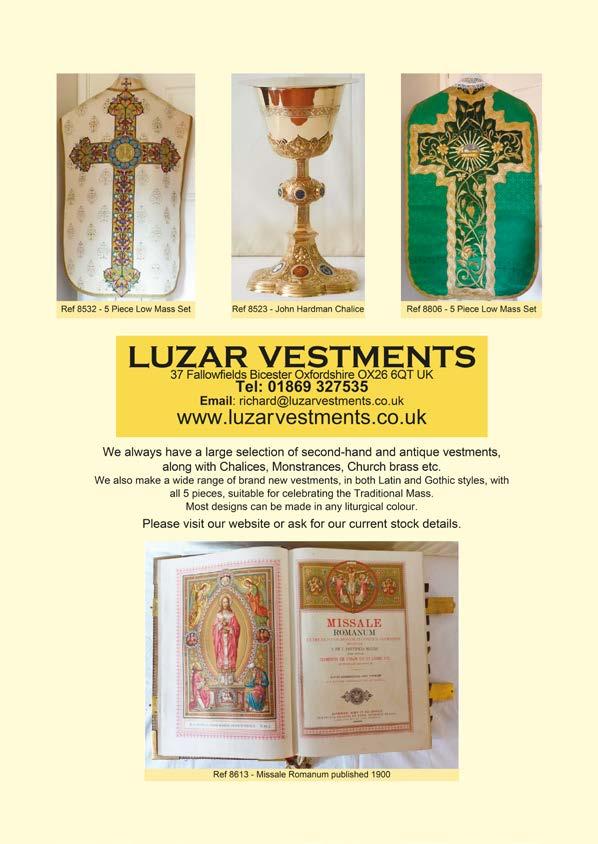
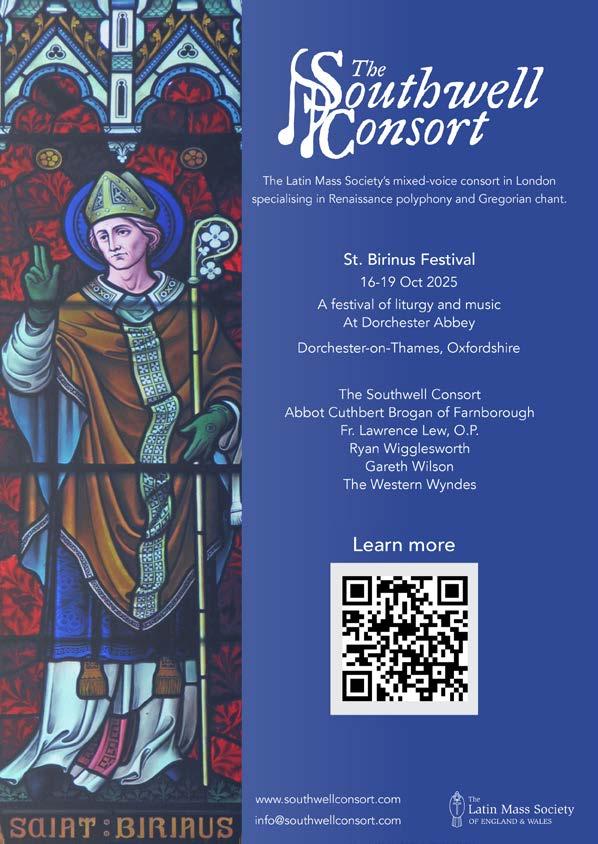
The Catholic Gael
Charles A. Coulombe remembers Ruaraidh Erskine of Mar
One of the more intriguing Catholic individuals in British culture and politics was Ruaraidh Erskine of Marr. He was born The Honourable Stuart Richard Joseph Erskine in Brighton, the third of four children born to William MacNaughton Erskine, 5th Baron Erskine, an army officer, and his wife, Caroline Alice Martha Grimble. The family were descendants of the Erskine Earls of Buchan and, as it happened, forbears as well –Ruaraidh’s nephew inherited the Earldom of Buchan in 1960, and the two lines were remerged.
In any case, Erskine learned to speak Scots Gaelic from his Harris-born nanny. His family were Recusants, but it is not clear if he was baptized into the Faith or converted later. But his background gave him three passions that would remain throughout his lifetime: the Catholic Church; the Jacobite cause and a strong Monarchy (which would be sufficient bond of union between the three kingdoms); and an intense love of Scotland, her native tongue, her culture, and her independence. He wanted to see Scots Gaelic raised to a high literary and cultural level and restored as the country’s major language.
The year 1888 saw the birth of the Neo-Jacobite Movement, with the founding of the Order of the White Rose by the Earl of Ashburnham and others. This fired young Erskine’s imagination. It was an amazing group. Filled with artists and writers, it bred both Celtic Nationalists, Catholic converts, and advocates of strong traditional Monarchy as the only rightful bond between what otherwise ought to be independent countries. Two years later, he and Herbert Vivian – who would become a long-term friend and ally – founded a weekly newspaper called The Whirlwind. It was Jacobite, frankly calling for the restoration of the Stuarts and a strong Monarchy binding the three
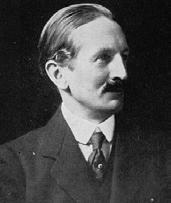
kingdoms together. Nationalism, peace, free trade, Irish Home Rule, and opposition to female suffrage and socialism characterized its other positions. It lasted only a year.
The Order of the White Rose was hardly a political pressure group, attracting primarily artists and Romantics (including Boston’s Ralph Adams Cram and Isabella Gardner). Hungering for something more overtly activist, in 1891 Erskine, Vivian and Melville Henry Massue, the Marquis de Ruvigny, broke with the OWR, and founded the Legitimist Jacobite League of Great Britain and Ireland. The same year, Erskine stood for the North Buteshire constituency as a Scottish Tory Home Ruler – but he withdrew before the election. He was president of the LJL in 1893, 1894, and 1897.
He returned to journalism in 1901, with the launch of the Gaelic language newspaper, Am Bàrd. It folded after a year, but in 1904, he launched what would be his most successful publication, Guth na Blaidhna (“The Voice of the Year”). A quarterly, and at first bilingual, it was unabashedly Catholic, while –despite being bilingual in the beginning – extremely supportive of the Gaelic
Revival. It also advocated an alliance of the Celtic peoples – to include the Bretons – as a counterpoint to their respective dominant nations. It would last until 1925. During its run, the publication brought him into contact with William Gillies; together they formed the Scots National League (SNL) in 1920.
But this was far from his only such venture in those years. In 1908-1909, he published the weekly Gaelic language newspaper, Alba. Dealing with such cultural matters as land, crofting, fishing, Scottish Gaelic-medium education, early Scottish history, and Gaelic song. Five years after its failure, he revived The Scottish Review. This was a political journal, and here was Erskine’s brief flirtation with the Left. Contributors included the Aberdonian trade unionist William Diack, James Maxton of the Independent Labour Party (ILP), the author and poet Lewis Spence, and the Welsh Nationalist MP Edward Thomas John.
Erskine and Gillies brought the SNL into the National Party of Scotland in 1928, but soon parted ways with the political Scots Nationalists. He continued his political interest in Catholicism, becoming ever more a Distributist. As with Harri Edwards and Saunders Lewis in Wales, he felt that the ever-more leftward trend of what became the SNP was as much a betrayal of the real Scotland as the Protestant Revolt had been. In sum, Erskine’s vision – elaborated in his 1931 book, Changing Scotland – was of an independent, re-Catholicised, and re-Gaelicised nation, with its own politically effective King (shared with similarly rejuvenated Ireland, England, Wales, Cornwall, and Man, and perhaps Canada, Australia, New Zealand, and South Africa, each ruled by His Majesty in his own right), as part of a re-Catholicised, Monarchical family of European nations. It might well be dismissed as utopian; but is there any better vision available to-day?
Erskine: his vision was an independent, re-Catholicised, and re-Gaelicised nation
CALENDARIVM
AUGUST
SEPTEMBER
OCTOBER
Mallow Street
“Il carnevale è finito”—the carnival is over. These words are attributed to Pope Francis, allegedly spoken to his Master of Ceremonies as he declined the traditional red papal mozzetta upon his election. Whether the story is fact or legend, it captures something real. In the Roman tradition, the end of Carnival marks the beginning of Lent—a season of austerity, self-examination, and spiritual testing in the wilderness. For many traditionally minded Catholics, the doctrinal ambiguities and liturgical restrictions of Francis’s pontificate came to feel like a kind of spiritual Lent—a prolonged period of trial and waiting for better times.
At the heart of Pope Francis' rationale for Traditionis Custodes—the first in a series of legal documents restricting the traditional Latin Mass—was a Vatican survey of the world’s bishops conducted in 2019–2020. In the accompanying letter, the Pope wrote that the bishops’ responses “reveal a situation that preoccupies and saddens me, and persuades me of the need to intervene.” Although the full results of the survey have not been made public,
a recent report by American journalist Diane Montagna has leaked the Vatican’s overall assessment and a selection of quotations from the world’s bishops.
A Holy See spokesman has played down the leak as “partial and incomplete” but its revelations are nonetheless explosive: they reveal that “the majority of bishops … state that making legislative changes to the MP Summorum Pontificum would cause more harm than good”. The assessment is essentially positive, highlighting outcomes from Benedict XVI’s restoration of the traditional liturgy—including increased participation by young people, families, and converts; deeper spiritual engagement; and liturgical catechesis impacting celebrations in the novus ordo. Far from sowing division, the leaked document is nuanced but essentially positive about the old rite; it proposes that seminarians be trained in the traditional liturgy and presents the traditional Latin Mass as generally enriching parish life and fostering ecclesial unity — directly contradicting the stated justification for Traditionis Custodes.

Some days before Montagna’s report, Cardinal Burke spoke at the Latin Mass Society’s sixtieth anniversary conference about a need for an end to “the persecution from within the church” of the traditional movement. The cardinal is a judicious man – a canon lawyer – who chooses his words with care and precision. He told us in no uncertain terms there has been a persecution and it has come from within the church.
Elsewhere in this edition of Mass of Ages, Frederick Wolf asks whether Pope Leo XIV will embrace the liturgical vision of Benedict XVI—a vision rooted not in rupture but in renewal. Pope Benedict told the world’s bishops that his rehabilitation of the traditional Latin Mass was “a matter of coming to an interior reconciliation in the heart of the Church”. His call was clear: “Let us generously open our hearts and make room for everything that the faith itself allows”. As a new pontificate begins, that appeal for reconciliation and renewal remains as urgent as ever.
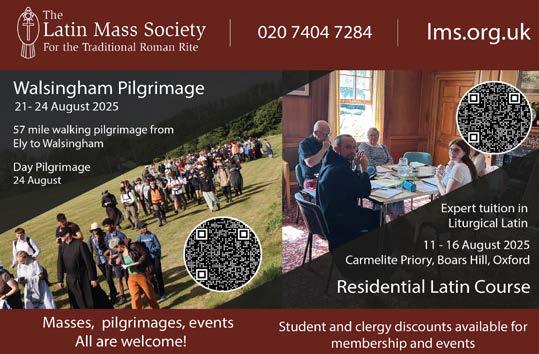

Alan Frost: August 2025
ANSWERS TO SUMMER 2025 CROSSWORD
Across: 1 Milvian 5 Elmer 8 Non 9 Narthexes 10 Tecum 11 Ignatians 14 Represent 18 Hindu 21 Schneider 22 Met 23 Adsum 24 Seducer Down: 1 Minotaur 2 Lunacy
3 In Nomine 4 Norman 5 Echo 6 Maxima 7 Rasa 12 Tethered 13 Sequitor 15 Pathos 16 Etudes 17 Anomie 19 Ossa 20 Meum
Lively in triple time music instruction (7) 5 & 24 Across: Liturgical book containing complete Gregorian Chant settings (5,7)
From Bach Suite No. 3 ‘on a G-string’ (3)
Removed by dentist or miner (9)
Italian term for church having cathedral features, especially in Florence (5)
Makes change to fit with new system (9)
Law enforcement officer (9)
‘ Come Holy -----, Creator come’ (5)
Milvian Bridge conqueror after seeing vision in the sky (9)
& 22 Across: Pietrelcina’s most famous Capuchin friar (5,3)
Positions oneself for the Credo in the Mass (6,2)
Famous London public school catering for Catholic boys (6)
Impressive though not necessarily sincere language (8)
Canadian city whose Catholic ‘Notre Dame’ Cathedral is its oldest church (6)
Wife of Jacob and sister of Rachel (4)
Use of anticlimax as a literary device (6)
Isle town near Quarr Abbey (4)
Maiden of the Bernese Alps’ highest mountain (8)
The fourteen stages of Our Lord’s Passion (8)
individual and story of (6)
major Czech River, Vltava, as referred to in English (6)
Written by an Evangelist (6)
Stung Vaughan Williams into composing said Overture? (4)
Decoration on a cotta (4)
Entries for the Autumn 2025 competition should be sent to the Latin Mass Society, or emailed to info@lms.org.uk, by 8 September.
The winner of the Summer 2025 crossword competition is Fr Richard Dwyer of Frome, who received a copy of Thomas More by R.W. Chambers. For a full range of Catholic books visit the LMS Shop: lms.org.uk/shop.
